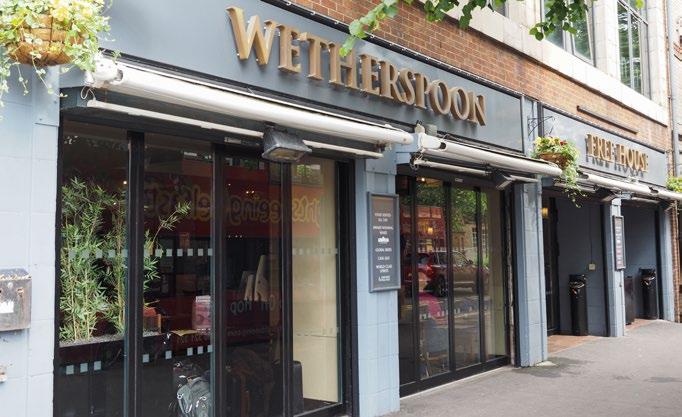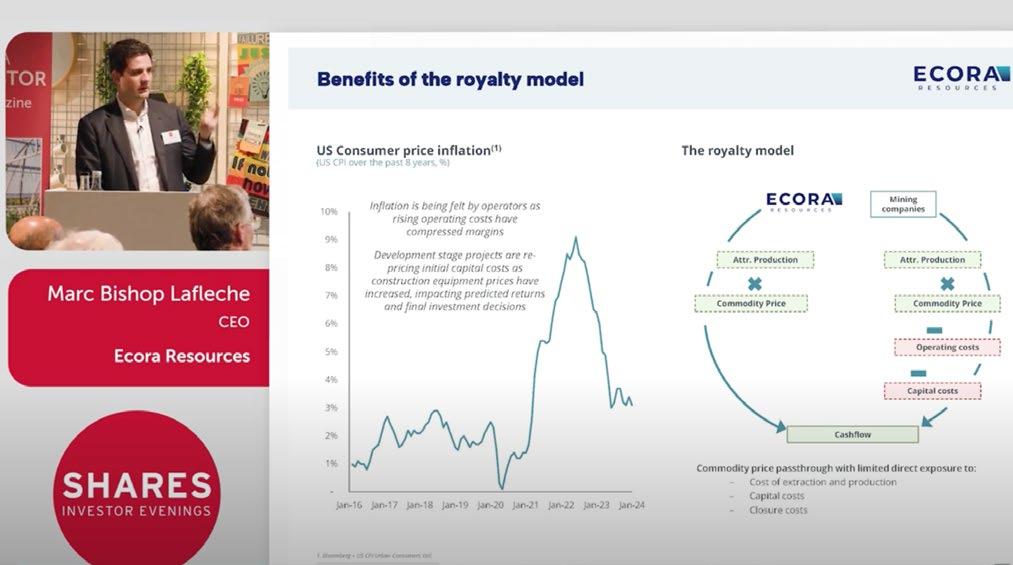INVEST IN FANTASY
The power of imagined worlds and the ways to play them

Will a US lawsuit take an even bigger bite out of its share price?
VOL 26 / ISSUE 12 / 28 MARCH 2024 / £4.49
APPLE:

•
•
•
The latest annual repor ts key information document (KID) and factsheets can be obtained from our website at www fidelity co uk/its or by calling 0800 41 41 10. The full prospectus may also be obtained from Fidelity The Alternative Investment Fund Manager (AIFM) of Fidelity Investment Trusts is FIL Investment Ser vices (UK) Limited Issued by FIL Investment Ser vices (UK) Limited, a firm authorised and regulated by the Financial Conduct Authority Fidelity, Fidelity International, the Fidelity International logo and F symbol are trademarks of FIL Limited Investment professionals include both analysts and associates Source : Fidelity International 30 September 2023. Data is unaudited UKM1223/384820/SSO/1224 Cut t hrou gh wit h convic tion FIDELIT Y INVESTMENT TRUSTS Truly global and award-winning, the range is supported by expert portfolio managers, regional research teams and on-the - ground professionals with local connections With over 450 investment professionals across the globe, we believe this gives us stronger insights across the markets in which we invest This is key in helping each trust identify local trends and invest with the conviction needed to generate long-term outperformance Fidelity’s range of investment trusts :
Fidelity Asian Values PLC
Fidelity China Special Situations PLC
Fidelity Emerging Markets Limited
•
•
•
Fidelity European Trust PLC
Fidelity Japan Trust PLC
Fidelity Special Values PLC
value of investments can go down as well as up and you may not get back the amount you invested Overseas investments are subject to currency fluctuations The shares in the investment trusts are listed on the London Stock Exchange and their price is affected by supply and demand
investment trusts can gain additional exposure to the market, known as gearing, potentially increasing volatility. Investments in emerging markets can more volatile that other more developed markets Tax treatment depends on individual circumstances and all tax rules may change in the future
find out more, scan the QR code, go to fidelity.co.uk/its or speak to your adviser. Available in an ISA
The
The
To
06 Why Apple US antitrust probe has spooked investors
07 Gold and stocks scale new heights after dovish Fed meeting
08 Activist investor buys into Scottish Mortgage as buyback is announced
09 Next shares reach new all-time high as earnings top estimates
09 Dowlais shares skid to record low on bumper provision
11 Outlook in focus as Hilton Food posts full-year results
12 Progress on job cuts and direct-to-consumer sales in focus at Levi Strauss
13 Markets move higher on more ‘dovish’ central bank comments
15 Why British Airways owner International
18 JPMorgan UK Small Cap Growth & Income:
20 Despite being an ‘old kid on the block’ F&C Investment Trust can still deliver strong returns




28 March 2024 | SHARES | 03 Contents NEWS
GREAT IDEAS
Consolidated
Airlines is worth buying
larger, more
lower costs UPDATES
liquid,
UNDER THE BONNET Spectris is another unrecognised long-term growth compounder FEATURES 28 COVER STORY INVEST IN FANTASY
power of imagined worlds and the ways to play them
Small world: a look at some of the month’s interesting small-cap stories 35 Sweet like chocolate: the total return stocks profiting from the sale of tasty treats 40 EMERGING MARKETS Why the Taiwanese market is more than just TSMC 43 FINANCE How to make the most of the big gilt revival 48 DANIEL COATSWORTH
catchy names like the Magnificent Seven hook in investors
ASK RACHEL How can you pay into a grandchild’s ISA? 59 EDITOR’S VIEW
do European companies really care about right now? 61 INDEX
funds, ETFs and investment trusts in this issue 33 48 52 28
22
The
33
How
52
What
Shares,
Three important things in this week’s magazine

Exploring the power of fantasy worlds
Shares looks at the firms which are cashing in on this growing genre and looks ahead to its potential in the metaverse.
Sweet like chocolate: the total return stocks profiting from the sale of tasty treats

Spectris is another unrecognised long-term growth compounder
W2 3
The sweet taste of success
With Easter just days away we dive into the world of the chocolatiers and pick a pair of winners.

Why is Spectris considered a ‘high-quality’ company? We explain what makes specialist engineering firm Spectris tick and why it is a favourite with fund managers.
Visit our website for more articles
Did you know that we publish daily news stories on our website as bonus content? These articles do not appear in the magazine so make sure you keep abreast of market activities by visiting our website on a regular basis.
Over the past week we’ve written a variety of news stories online that do not appear in this magazine, including:




04 | SHARES 28 March 2024 Contents
28 March 2024 | SHARES 35 Feature Shares in chocolate makers have soured due to short-term headwinds, but long-term investors could potentially still benefit from their compounding power One of the chocolate industry’s seasonal peaks, Easter is upon us with eggs from the world’s major brands adorning retailer’s shelves. Chocolates are tough for consumers to resist at this time of year, but is this an opportune time to put money to work with purveyors of one of the world’s most popular little luxuries? SWEET CONSUMER CATEGORY According to MarkNtel Advisors, the global chocolate market was valued at $421 billion in 2023 and is forecast to grow at a CAGR (compound annual growth rate) of around 4.7% between 2024 and 2023, with growth supported by the consumer’s sweet tooth and increasing demand for organic, vegan, sugar-free, and gluten- free chocolates from more health-conscious chocoholics.
Chocolate, snacks and confectionery have been great consumer categories for decades and with consumption rising in emerging markets amid the expansion of the middle classes, exciting long-run opportunities exist for the snack food conglomerates that dominate the industry. Sales growth from this sub-sector of the consumer staples industry can be pedestrian at times, but resilient demand and the pricing power the key players possess, conferred by must-have brands, translates into robust cash flows and progressive dividends which investors can then reinvest. This means the small band of publicly listed chocolate sellers have the capacity at least to deliver decent total returns. INFLATIONARY PRESSURES LEAVE SOUR TASTE However, as prices have risen to offset elevated cocoa and sugar costs, chocolate market growth has recently slowed in the EU and the US, as the Morgan Stanley charts provided demonstrate, and the risk is further price increases will impact volumes going forwards. Cocoa is scaling record highs as adverse weather in major growing regions, tree illness and capacity shortages lead to expectations of an even wider supply deficit this season, which could create a headwind to volumes for chocolate companies as pricesIndustryrise.heavyweights Hershey (HSY:NYSE), the Milton Hershey-founded, Michele Buck-bossed chocolatier behind some of planet Earth’s most popular candies, and Dairy Milk maker Mondelez International (MDLZ:NASDAQ), have recently served up slower growth as consumers rein in spending in response to price hikes. Cocoa prices have soared 1970 1980 1990 2000 2010 2020 0 1,000 2,000 3,000 4,000 5,000 Chart: Shares magazine Source: LSEG 22 SHARES 29 March 2024 Under the Bonnet:Spectris Analysts have low-balled earnings estimates for this year
henever there is a discussion about ‘quality’ UK industrial stocks, the name Spectris (SXS) is often thrown into the ring although we suspect many investors, while being familiar with the company in a general sense, have little idea what it actuallyLookingdoes. on Stockopedia, the company has a 99th percentile quality ranking, which backs up its reputation, but it is classified as a large-cap technology stock and a ‘high-flyer’, which doesn’t help a great deal in explaining the business. So, what does Spectris actually do and is it an interesting investment? A BRIEF INTRODUCTION Spectris is divided into two main business units, making precision measurement equipment and software for some of the world’s most technically demanding applications, from aerospace and electronics to electric vehicles, and helping to solve a myriad of environmental issues such as monitoring and reducing micro-plastics and even working out how Galapagos tortoises self-right themselves. Spectris Scientific makes equipment for material analysis for the pharmaceutical, semiconductor and materials sectors, measuring particles down to the nano scale to help its customers shape everything from proteins, metals and polymers to controlling the manufacturing process, and contributes 56% of the group’s turnover. Spectris Dynamics is a global leader in advanced virtual and physical testing and high- precision sensors for the automotive, machine manufacturing, aerospace and technology sectors, and contributes the remaining 44% of group turnover. It works in what it calls attractive, sustainable, structural growth markets with high barriers to entry, using an asset-light model and investing
Analysts are expecting a big slowdown in organic growth this year Revenue £1.45bn £1.5bn LFL change 9.7% 3.4% Adj ProfitOperating £262m £272m Operating Margin 18.1% 18.1% EPS 199p 207p DPS 79.2p 86.3p 2023 Actual 2024 Forecast Table: Shares magazine Source: Spectris company-compiled consensus as of 24 February 2024 Spectrishelpssolveamyriadofenvironmentalissuesincluding workingouthowGalapagostortoisesself-rightthemselves 28 SHARES | 28 March 2024 The world of fantasy is clearly having a moment. The rise of ‘romantasy’ authors like Sarah J Maas, who has been a big part of UK publishing outfit Bloomsbury’s (BMY) recent success, have taken the genre out of its previous male-dominated realm to a whole new audience. Bloomsbury’s surging sales and the ongoing phenomenon that is Games Workshop (GAW) are two examples on the UK market which show the devotion fantasy worlds can inspire. Warren Buffett disciple and manager of CFP SDL UK Buffettology General (BKJ9C67) Keith Ashworth-Lord once described Games Workshop, which represents 9% of the portfolio, as the ‘nearest thing to legal drug dealing on the stock market’, with the tabletop games firm ticking one of the key boxes he looks for in a business: capturing a piece of its customers’ minds. But this concept is a global one which is applicable beyond the fantasy genre. Imagined worlds are powerful – connecting with people on an emotional and intellectual level and driving a connection which creates significant barriers to entry and pricing power for the owners of the relevant intellectual property.
power of imagined worlds and the ways to play them INVEST FANTASYIN The metaverse and virtual reality could strengthen the bond between people and their favourite characters and worlds
ignites investors’ imagination as shares rise
The
Reddit IPO
48% on debut
Phoenix shares take flight after results blow past forecasts
FTSE 100 within touching distance of new all-time high
7%
JD Wetherspoon shares fall
on slowing sales growth 1

There’s no better investment return than the freedom to live well Whatever your financial goals, a Janus Henderson Investment Trust invests for your future actively, expertly and diligently. Whether you’re looking for growth or a steady income, our range of trusts aims for competitive returns across a diverse selection of global investments. And with decades of investment trust experience behind us, you can look forward with confidence. Explore our Investment Trust range at www.janushenderson.com/JHIT INVESTMENT TRUSTS Marketing communication. Not for onward distribution. The value of an investment and the income from it can fall as well as rise and you may not get back the amount originally invested. Not for distribution in European Union Member countries. Issued in the UK by Janus Henderson Investors. Janus Henderson Investors is the name under which investment products and services are provided by Janus Henderson Investors International Limited (reg. no. 3594615), Janus Henderson Investors UK Limited (reg. no. 906355), Janus Henderson Fund Management UK Limited (reg. no. 2678531), (each registered in England and Wales at 201 Bishopsgate, London EC2M 3AE and regulated by the Financial Conduct Authority) and Janus Henderson Investors Europe S.A. (reg. no. B22848 at 2 Rue de Bitbourg, L-1273, Luxembourg and regulated by the Commission de Surveillance du Secteur Financier). Janus Henderson is a trademark of Janus Henderson Group plc or one of its subsidiaries. © Janus Henderson Group plc
Why Apple US antitrust probe has spooked investors
Technology giant faces threat to key Services arm
Technology giant Apple (AAPL:NASDAQ) is facing an epic fight with regulators after the US Department of Justice launched a lawsuit accusing the iPhone maker of violating antitrust laws and suppressing competition by blocking rivals from accessing hardware and software features on its devices.
The challenge, announced last week (21 March), saw shares in Apple lose more than 4%, their biggest one-day fall since August 2023 according to Bloomberg. The decline also brings Apple’s year-todate slide to 11%, erasing around $293 billion from its market value.
The sell-off stands in contrast to the rest of big tech. The US-listed Roundhill Magnificent Seven ETF, which tracks the performance of the ‘Magnificent Seven’ stocks, is up 19% year-to-date.

Antitrust legal challenges are par for the course in the technology industry, but they are typically brushed off by analysts and investors with most eventually settled by hefty fines before being consigned to history. But Apple now finds itself under threat on three of its most important fronts – Europe, China and now its own backyard.
Apple became a powerhouse stock due to its innovation and growth, but without iconic chief executive Steve Jobs at the helm innovation has come to a standstill. The company killed its multiyear attempt to build an electric car, is behind in the AI race, and has been unimpressive in delivering the ‘wow’ factor in new iPhone releases.
The US suit also puts Apple’s Services business in the watchdog’s crosshairs, the firm’s biggest source of growth in recent years. Home to the App Store, Apple Pay and Apple Music, and fed

by more than two billion Apple devices in use, services revenue expanded 9% in fiscal 2023 while product revenue, including iPhones, Macs and iPads, dropped 3%. Adding to the threat, despite only accounting for 22% of Apple’s sales, services generated more than a third of profit.
Analysts have flagged similarities to the groundbreaking antitrust battle that brought the US and Microsoft into opposition in the 1990s, with Apple now having to defend itself over accusations it has abused the significant power it has accumulated over users.
The decline also brings Apple’s year-to-date slide to 11%, erasing around $293 billion from its market value”
Despite the heightened threat to Apple, Morningstar analysts remain supportive. ‘We still believe most Apple users opt into the firm’s premium closed ecosystem, and we don’t predict significant attrition for the firm’s products and services even in a more open environment,’ said William Kerwin.
‘We assume the suit will result in some opening of Apple’s walled garden ecosystem, similar to what we expect from the European Union’s Digital Markets Act,’ added Kerwin. [SF]
News 06 | SHARES | 28 March 2024
Apple ($) Jan 2024 Feb Mar 170 175 180 185 190 195 Chart: Shares magazine • Source: LSEG
Gold and stocks scale new heights after dovish Fed meeting
For investors, what Federal Reserve chair Jay Powell says during press conferences following interest rate decisions is more important than the official statement accompanying each rate decision.
In other words, monetary policy is set by the communication of rate decisions rather than the decisions themselves.
This distinction was more pronounced than usual at the 20 March meeting which, for the record, saw the central bank leave benchmark federal funds rate unchanged in the range of 5.35% to 5.5%.
Powell’s comments on interest rates, inflation and the Fed’s balance sheet were interpreted as dovish when compared with the Fed’s official statement and updated summary of economic projections which were decidedly hawkish.
Investors took on the board the message and promptly chased the S&P 500 to yet another new all-time high which it has done no fewer than 20 times so far in 2024. In other words, markets are doing the Fed’s work.
Notably, the move higher in shares was also accompanied by a record high in the price of gold which breached $2,200 per troy ounce for

the first time.
While there are other factors at play, such as central banks accumulating the yellow metal at a record pace over the last two years, the high price may also reflect worries over stickier mediumterm inflation.
Investors appear to be taking the view the Fed will let inflation run higher for longer while maintaining its official line of bringing it back to its 2% target.
On inflation for example, despite recent evidence of core inflation coming in hotter than expected, Powell suggested this could be due to ‘seasonal’ factors, implying the solid progress made at the back end of 2023 was likely to reappear.
There also seems to be a shift in emphasis towards protecting the labour market.
On the surface the US labour market appears healthy with 275,000 new jobs created in February, but broader measures are showing signs of weakness which Powell acknowledges.
For example, the NFIB (National Federation of Independent Businesses) hiring survey shows a decline in hiring intentions in recent months.
So far, the Fed has done a good job of balancing the needs of the economy with reducing inflation. By its own admission the central bank is not sure how restrictive its policy stance is or how long it will take to bring inflation down to target.
Investors are looking past the conundrum and following the old maxim of ‘don’t fight the Fed’. This is reflected in all-time highs for riskier assets such as stocks and Bitcoin, tight bond yield spreads and a resurgence of initial public offerings. [MG]
News 28 March 2024 | SHARES | 07
With stocks at all time highs financial conditions do not appear restrictive S&P 500 vs gold 1970 1980 1990 2000 2010 2020 0 2,000 4,000 S&P 500 Gold bullion LBM $/t oz Rebased to 100 Chart: Shares magazine • Source: LSEG
Activist investor buys into Scottish Mortgage as buyback is announced
Elliott Advisors has shifted its focus from Curry’s to investment trusts
It has been a busy time for shareholders in Scottish Mortgage Investment Trust (SMT), but it has been a fruitful time too with the shares hitting new 12-month highs in March.
First, the board announced it would buy back at least £1 billion worth of shares in order to help narrow the discount to NAV (net asset value).
Then, Delaware-based Elliott Advisors revealed it had taken a 5% stake in the trust through the purchase of shares and derivatives.
A quick look at trading in Scottish Mortgage over the last fortnight shows a big spike in volume on 15 March – the same day the board announced the share buyback plan – and again on 19 March.
Iain Scouller, head of investment trust research at Stifel, posits asking the trust’s board ‘Were you aware there was stake building underway when you announced the £1 billion buyback?’.
‘The market is likely to suspect the board was aware some significant trading activity was afoot, though perhaps not knowing which investor was behind it, and this was one factor in the timing of the buyback announcement.’
Scouller suggests the board may have hoped that by announcing a buyback the discount would narrow enough to dissuade would-be activists from buying shares in the near term.
Given Elliott has previous form in campaigning for change at trusts – and has had notable success to boot – the board may now be hoping the firm trades out of the shares for a quick gain if the discount narrows further.
However, given the shares have already bolted on these two bits of news, £1 billion is now only enough to buy around 8% of the trust over two years, or 4% each year, which looks less impressive than at first glance compared with Elliott’s stake.
Mortgage
highlights, Scottish Mortgage shares historically traded at a premium to NAV so Elliott may be looking for a free ride as the discount narrows although that doesn’t get to the root of the problem.
‘Part of Scottish Mortgage’s share price weakness was down to rising interest rates which negatively affected valuations of companies where the story is about future cash flow. As the share price fell, there were also suggestions that Scottish Mortgage had been taking too many wild bets on blue-sky companies that were miles off making any money,’ says Coatsworth.

Having fewer unquoted stocks would mean a more liquid portfolio but would also deprive the trust of future IPO candidates, he adds. [IC]
DISCLAIMER: Financial services
As AJ Bell investment analyst Dan Coatsworth
company AJ Bell referenced in this article owns Shares magazine. The author of this article (Ian Conway) and the editor (Tom Sieber) own shares in AJ Bell.
News 08 | SHARES | 28 March 2024
Scottish
(p) 2020 2021 2022 2023 2024 400 600 800 1,000 1,200 1,400 Chart: Shares magazine • Source: LSEG
Next shares reach new all-time high as earnings top estimates
The firm is in ‘a more positive frame of mind’ than it has been for years
Shareholders in retail bellwether Next (NXT) were breaking out the champagne after the stock price hit a new lifetime high on the release of forecast-beating results for the year to January (21 March).
Full-price sales rose a betterthan-expected 4%, with growth driven by strong online trading, suggesting the retailer’s offering continues to resonate with shoppers.
Chief executive Simon Wolfson opened his comments by saying it was
‘a long time since we started a year in a more positive frame of mind’, as the firm ended 2023 with its highest-ever levels of revenue and profit and entered 2024 ‘with new avenues of growth along with a cost base that feels under control’.
Earnings this year are seen rising just under 5% to around £960 million while the firm intends to return £540 million in dividends and buybacks. Progress is expected outside the UK with more US retailers hopefully signing up for trials and franchising

and licensing agreements agreed with leading players in India and Asia.
Shore Capital described the firm as ‘a high-class act with a deserved equity capital market following because there is a more than reasonable chance that it will beat its guidance’. [IC]
Dowlais shares skid to record low on bumper provision
Charge overshadowed the group’s strong underlying performance last year
Investors in automotive products maker Dowlais (DWL) were drowning their sorrows as the shares hit their lowest level since the firm spun out of conglomerate Melrose Industries (MRO) last year and listed as a stand-alone entity.
The group’s underlying performance for 2023 was steady if not spectacular, helped by a banner year for UK vehicle production with output topping one million units for the first time since 2019, and the board recommended an increased dividend and a
share buyback of up to £50 million.
Chief executive Liam Butterworth hailed the firm’s ‘significant progress and transformation’ in 2023 along with its strong financial and operational performance, ‘demonstrating resilience, expanding margins, generating free cash flow above our expectations and reducing our financial leverage’.
However, as part of the spinoff process the firm had to ‘take ownership’ of the powder metallurgy business, the value of which it decided to write down by £450 million after reviewing its prospects.
That sent the bottom line into deficit by a similar amount and sent the shares

News 28 March 2024 | SHARES | 09
DOWN in the dumps
Moving
HIGHER
crashing almost 10% to a new low of 81.2p. [IC] Next Apr 2023 Jul Oct Jan 2024 Apr 7,000 8,000 9,000 Chart: Shares magazine • Source: LSEG Dowlais (p) Jul 2023 Oct Jan 2024 Apr 100 120 140 Chart: Shares magazine • Source: LSEG
Sophisticated global investing made effortless
Since

Enjoy sophisticated investing made available to everyone at www.janushenderson.com/BNKR
a wide range of quality global investments in
expertly blended
growth and
1888, The Bankers Investment Trust has enabled people to access
one
portfolio. Targeting long-term
income, for those aiming to invest for their future.
BANKERS INVESTMENT TRUST Marketing communication. Not for onward distribution. The value of an investment and the income from it can fall as well as rise and you may not get back the amount originally invested. Not for distribution in European Union Member countries. Issued in the UK by Janus Henderson Investors. Janus Henderson Investors is the name under which investment products and services are provided by Janus Henderson Investors International Limited (reg. no. 3594615), Janus Henderson Investors UK Limited (reg. no. 906355), Janus Henderson Fund Management UK Limited (reg. no. 2678531), (each registered in England and Wales at 201 Bishopsgate, London EC2M 3AE and regulated by the Financial Conduct Authority) and Janus Henderson Investors Europe S.A. (reg. no. B22848 at 2 Rue de Bitbourg, L-1273, Luxembourg and regulated by the Commission de Surveillance du Secteur Financier). Janus Henderson is a trademark of Janus Henderson Group plc or one of its subsidiaries. © Janus Henderson Group plc
Outlook in focus as Hilton Food posts full-year results
It’s already clear 2023 was a year of recovery after a difficult 2022 Retail meat- and fish-packing business Hilton Food (HFG) is set to report its full-year results on 3 April.
The company gave a pretty clear picture of its 2023 performance in a January trading update so the spotlight is likely to be on the outlook for 2024 and recent trading.
Hilton was hit by two damaging profit warnings in 2022, largely relating to problems in its UK seafood operation.
The business runs automated and robotised food processing, packing and logistics facilities for major international retailers across Europe, Asia Pacific and North America, and through economies of scale is able to
UK
UPDATES OVER T HE NEXT 7 DAYS
FULL-YEAR RESULTS
3 April: Hilton Food, Pantheon Infrastructure

secure significant efficiency savings for customers while also carving out a decent margin for itself.
Commenting on the January update, Shore Capital said: ‘Management also looks to the more medium term with confidence as it continues to explore opportunities in both new and existing markets to underpin its strategy to be the international protein partner of choice, with its combination of a highlyautomated supply chain, leading technology and multi-category food capabilities expected to drive sustained growth.’
The broker also noted ‘the breadth of growth
What the market
opportunities that have been cultivated across a range of international markets and protein categories, supported by the monetisation of the automation and technology capabilities now operating under the Greenchain Solutions umbrella’. [TS]
What the market

News: Week Ahead 28 March 2024 | SHARES | 11
Hilton Food (p) Apr 2023 Jul Oct Jan 2024 Apr 700 800 Chart: Shares magazine • Source: LSEG
expects of Hilton Food 2023 50.4p £4.05bn 2024 60.6p £4.2bn EPS Revenue Table: Shares magazine • Source: Stockopedia
What the market
expects of Hilton Food 2023 50.4p £4.05bn 2024 60.6p £4.2bn EPS Revenue Table: Shares magazine • Source: Stockopedia
expects of Hilton Food 2023 50.4p £4.05bn 2024 60.6p £4.2bn EPS Revenue Table: Shares magazine • Source: Stockopedia
Progress on job cuts and direct-to-consumer sales in focus at Levi Strauss
Shares

Iconic denim products maker Levi Strauss (LEVI:NYSE) may be one of the oldest companies in the US, tracing its origins all the way back to 1853, but it remains highly relevant today.
It regularly scores near the top in apparel brand rankings in both the US and internationally and the company’s shares are on a strong run ahead of its first-quarter numbers (to the end of February) on 3 April.
Earnings have consistently come in ahead of expectations in recent quarters, although those expectations have been pitched pretty low at times as management have guided them down. This will be the first release under new chief executive Michelle Gass who took
over from Chip Bergh on 29 January. There was modest disappointment in January when the fourth-quarter earnings were accompanied by a muted outlook. Shareholders will be looking for an update on plans to cut between 10% and 15% of the firm's global workforce in the first half of 2024 with the aim of saving $100 million in costs for the year to 30 November 2024.
The company is also trying to sell more through its own physical stores and website rather than through third parties. Retailers are still pretty cautious about taking on too much stock amid fairly muted consumer demand over the last couple of years thanks to cost-of-living pressures. [TS]
US UPDATES OVER THE NEXT 7 DAYS
QUARTERLY RESULTS
1 April:
PVH, Nano X
2 April: Freedom
3 April: Acuity Brands, Blackberry, Acuity Brands, Novagold, Levi Strauss
4 April: RPM, Lamb Weston Holdings, Simply Good Foods

News: Week Ahead 12 | SHARES | 28 March 2024
in the
brand have
in
Levi Strauss ($) Apr 2023 Jul Oct Jan 2024 Apr 14 16 18 Chart: Shares magazine • Source: LSEG What the market expects of Levi Strauss Q1 forecast $0.20 $1.53bn EPS Revenue Table: Shares magazine • Source: Zacks What the market expects of Levi Strauss Q1 forecast $0.20 $1.53bn EPS Revenue Table: Shares magazine • Source: Zacks What the market expects of Levi Strauss Q1 forecast $0.20 $1.53bn EPS Revenue Table: Shares magazine • Source: Zacks
iconic denim
enjoyed a strong run
recent months
Markets move higher on more ‘dovish’ central bank comments
Three UK and US interest rate cuts are being penciled in this year
As expected, there was no change in benchmark interest rates either in the UK or the US last week but markets found plenty to like in the commentaries from both central banks.
Bank of England governor Andrew Bailey sounded more optimistic on rate cuts than many had predicted given inflation is still over
3% against the bank’s official 2% target.

Macro diary 28 March to 04 April 2024
Macro diary 28 March to 04 April 2024
Macro diary 28 March
Bailey told the BBC: ‘We don't have to actually get inflation all the way back to target… to cut rates for instance, what we have to do is be convinced that it is going there. We should act ahead of time in that sense because we have to be forward looking.’
He also said it was ‘reasonable’ for financial markets to price in two or three rate cuts this year given the ‘very encouraging’ progress on bringing inflation down so far.
In a similar vein, Federal Reserve chair Jerome Powell said strong recent inflation data didn’t change ‘the overall story, which is that of inflation moving down gradually on a sometimes bumpy road to 2%’.
Powell also confirmed market expectations of three interest rate cuts this year, although he stressed the timing depended on officials becoming more confident inflation was coming down adding ‘it’s appropriate for us to be careful’.
Next week sees the release of both manufacturing and services indices in the UK, the US and the Eurozone, all of which will be widely watched.
Focus will also be on the US jobs market where there are several data points for the Federal Reserve to parse while it considers the next step in its interest-rate policy in early May. [IC]
News: Week Ahead 28 March 2024 | SHARES | 13
28-Mar US Q4 GDP 3.2% 29-Mar US February Core PCE Price Index 2.8% 01-Apr US March ISM Manufacturing 47.8 02-Apr UK March Nationwide House Price Index 1.2% UK March Manufacturing PMI 49.9 Eurozone March Manufacturing PMI 45.7 US February JOLTS Job Openings 8.86m 03-Apr Eurozone March CPI 2.6% US March Non-Farm Payrolls 140k US March Services PMI 51.7 04-Apr UK March Services PMI 53.4 Eurozone March Services PMI 51.1 US March Challenger Job Cuts 84.6k Date Economic Event Previous Table: Shares magazine • Source: Morningstar, central bank websites
28-Mar US Q4 GDP 3.2% 29-Mar US February Core PCE Price Index 2.8% 01-Apr US March ISM Manufacturing 47.8 02-Apr UK March Nationwide House Price Index 1.2% UK March Manufacturing PMI 49.9 Eurozone March Manufacturing PMI 45.7 US February JOLTS Job Openings 8.86m 03-Apr Eurozone March CPI 2.6% US March Non-Farm Payrolls 140k US March Services PMI 51.7 04-Apr UK March Services PMI 53.4 Eurozone March Services PMI 51.1 US March Challenger Job Cuts 84.6k Date Economic Event Previous
Shares magazine • Source: Morningstar, central bank websites
Table:
to 04 April 2024 28-Mar US Q4 GDP 3.2% 29-Mar US February Core PCE Price Index 2.8% 01-Apr US March ISM Manufacturing 47.8 02-Apr UK March Nationwide House Price Index 1.2% UK March Manufacturing PMI 49.9 Eurozone March Manufacturing PMI 45.7 US February JOLTS Job Openings 8.86m 03-Apr Eurozone March CPI 2.6% US March Non-Farm Payrolls 140k US March Services PMI 51.7 04-Apr UK March Services PMI 53.4 Eurozone March Services PMI 51.1 US March Challenger Job Cuts 84.6k Date Economic Event Previous Table: Shares magazine • Source: Morningstar, central bank websites Next Central Bank Meetings & Current Interest Rates 11-Apr European Central Bank 4.5% 01-May US Federal Reserve 5.5% 09-May Bank of England 5.25% Date Event Previous Table: Shares magazine • Source: Morningstar, central bank websites Next Central Bank Meetings & Current Interest Rates 11-Apr European Central Bank 4.5% 01-May US Federal Reserve 5.5% 09-May Bank of England 5.25% Date Event Previous Table: Shares magazine • Source: Morningstar, central bank websites Next Central Bank Meetings & Current Interest Rates 11-Apr European Central Bank 4.5% 01-May US Federal Reserve 5.5% 09-May Bank of England 5.25% Date Event Previous Table: Shares magazine • Source: Morningstar, central bank websites

Invest in a portfolio built for lifetimes A favourite with investors looking for long-term, dependable returns, The City of London Investment Trust is well regarded for its dividend increases and capital growth prospects. The Trust invests in leading businesses that are listed on the London Stock Exchange, providing investors with a good-value gateway to large, international companies. Create a lasting investment legacy at www.janushenderson.com/CTY CITY OF LONDON INVESTMENT TRUST Marketing communication. Not for onward distribution. The value of an investment and the income from it can fall as well as rise and you may not get back the amount originally invested. Not for distribution in European Union Member countries. Issued in the UK by Janus Henderson Investors. Janus Henderson Investors is the name under which investment products and services are provided by Janus Henderson Investors International Limited (reg. no. 3594615), Janus Henderson Investors UK Limited (reg. no. 906355), Janus Henderson Fund Management UK Limited (reg. no. 2678531), (each registered in England and Wales at 201 Bishopsgate, London EC2M 3AE and regulated by the Financial Conduct Authority) and Janus Henderson Investors Europe S.A. (reg. no. B22848 at 2 Rue de Bitbourg, L-1273, Luxembourg and regulated by the Commission de Surveillance du Secteur Financier). Janus Henderson is a trademark of Janus Henderson Group plc or one of its subsidiaries. © Janus Henderson Group plc
Why British Airways owner International Consolidated Airlines is worth buying

Strong consumer demand and premium leisure offerings are helping to support its turnaround in fortunes
International Consolidated Airlines (IAG) 162p
Market cap: £7.98 billion
Unloved by investors during the pandemic British Airways owner International Consolidated Airlines (IAG) has experienced a revival of fortunes due to strong consumer demand and holidaymakers paying higher ticket prices. Despite the ongoing cost-ofliving crisis – people are still prioritising holidays.
In a recent full year trading update at the end of February, the airline group said it had restored 95.7% of 2019 capacity.
Passenger unit revenue for the year was 8.2% higher than in 2022 ‘with strong leisure traffic recovery and business traffic recovering more slowly’ although the premium leisure segment continued to perform ‘very well’.
Operating profits nearly tripled from €1.3 billion to €3.5 billion surpassing the previous record of €3.3 billion made by the company pre-pandemic in 2019.
The group, which also owns Spain’s Iberia and Ireland’s Aer Lingus, has a positive outlook for 2024 and is generating significant free cash flow.
We don’t think this improving picture is reflected in an extremely grudging price to earnings ratio of just 4.5 times based on 2024 consensus forecasts.
IMPROVING SENTIMENT
The airline group is at least getting a more sympathetic hearing from the analyst community.
Great Ideas: Investments to make today 28 March 2024 | SHARES | 15
International
(p) 2020 2021 2022 2023 2024 100 200 300 400 Chart: Shares magazine • Source: LSEG
Consolidated Airlines
Great Ideas: Investments to make today
Analyst James Hollins from French investment bank BNP Paribas recently observed the company had: ‘Fixed our bear thesis; leverage is down. British Airways is improving, Iberia is at record strength, shareholder returns are resuming, Heathrow is full again and core wage deals are fixed mid-term.’
Savi Syth, analyst at US investment bank, Raymond James highlights: ‘IAG’s greater exposure to favourable trends in the transatlantic and intraEuropean markets, improving competitive capacity set up, and opportunity to initiate cash returns to shareholders.’
The company has adapted to and acknowledged the post-pandemic realities of flying in Europe grabbing a high share of transatlantic traffic and offering premium leisure travel to consumers.
It is making improvements to its service which could help it maintain and grow its market share. There is planned investment in areas including a digital concierge service, WhatsApp text assistant and call-centre Smart Voice assistant.
There will also be touchpoints across the airport journey, better digital self-service in disruption and digital assistance in the customer care channel.
British Airways customers will benefit from increased in-flight entertainment and a premium proposition across its cabins. The airline is also going to further develop its call centre in Delhi using better IT and systems and an initiative-taking care team.
WORST IS OVER
Analyst Nicholas Mauder of Kepler Cheuvreux no longer believes the airline operator will see a passenger yield decline this year. Passenger yield is

an important metric for the airline sector – it shows the average fare paid per mile or kilometre, per passenger.
Mauder has significantly increased his EBIT (earnings before interest and taxation) estimate for 2024 to €3.74 billion.
Mauder says the company has the cleanest unit cost outlook among its counterparts. He adds: ‘Our (significantly increased) estimates are above consensus, and an eventual share buyback could be the catalyst the market needs to acknowledge the value we see in IAG shares.’
FUEL COST WORRIES
The main sticking points for the company are slower than expected recovery of business travel and ongoing volatility in the cost of fuel.
In the recent annual results, the company noted fuel unit costs were up 0.7% versus 2022, however the group’s investment in more fuel-efficient aircraft should help offset increased costs of emissions trading schemes.
The airline is 92% booked for the first quarter of 2024 and 62% booked for the first half of 2024, ahead of last year on both measures.
The company plans to grow capacity by around 7% in 2024 and rebuild its pre-pandemic long haul capacity and grow Iberia in the attractive Latin American market. [SG]
16 | SHARES | 28 March 2024
Airlines - consensus forecasts € € 2024E 31.0 billion 0.4 2025E 32.3 billion 0.5 Revenue Earnings per share (EPS) Table: Shares magazine • Source: Stockopedia
International Consolidated

Jump on the engines of European growth Join Europe’s dynamic smaller companies on their journey to success, as they drive strong, consistent potential returns for investors. The European Smaller Companies Trust discovers and invests in the businesses that are powering the exciting transformation of today and tomorrow. Let them power your portfolio too at www.janushenderson.com/ESCT EUROPEAN SMALLER COMPANIES TRUST Marketing communication. Not for onward distribution. The value of an investment and the income from it can fall as well as rise and you may not get back the amount originally invested. Not for distribution in European Union Member countries. Issued in the UK by Janus Henderson Investors. Janus Henderson Investors is the name under which investment products and services are provided by Janus Henderson Investors International Limited (reg. no. 3594615), Janus Henderson Investors UK Limited (reg. no. 906355), Janus Henderson Fund Management UK Limited (reg. no. 2678531), (each registered in England and Wales at 201 Bishopsgate, London EC2M 3AE and regulated by the Financial Conduct Authority) and Janus Henderson Investors Europe S.A. (reg. no. B22848 at 2 Rue de Bitbourg, L-1273, Luxembourg and regulated by the Commission de Surveillance du Secteur Financier). Janus Henderson is a trademark of Janus Henderson Group plc or one of its subsidiaries. © Janus Henderson Group plc
JPMorgan UK Small Cap Growth & Income: larger, more liquid, lower costs
Enlarged trust is a canny way to capture a rerating of unloved UK small cap stocks
JPMorgan UK Small Cap Growth & Income (JUGI)
293.5p
Market cap: £403.4 million
Amajor trend in the investment trust sector is mergers between sub-scale trusts with similar remits to create funds large enough and sufficiently liquid to attract wealth managers and retail investors.
One example which Shares believes offers a compelling proposition is JPMorgan UK Small Cap Growth & Income (JUGI), which is the resut of the combination of JPMorgan UK Smaller Companies and stablemate JPMorgan Mid Cap, which shared the same managers and had plenty of portfolio overlap.
With assets now knocking on £500 million, the enlarged entity is more liquid, has lower fees spread across a broader asset base and a wider investment universe. Furthermore, the name change reflects a new enhanced dividend policy targeting a 4% yield on NAV (net asset value) to be paid from a combination of income and capital.
Trading at an attractive 12.5% discount to NAV, the trust offers a stronger total return with income alongside the capital growth potential of the small-cap asset class where valuations remain attractive in absolute and relative terms as shown by surge in M&A activity.
JP Morgan Small Cap Growth & Income
tomorrow’s medium- and large-caps.
The trust’s greater scale gives Brittain and Patel the freedom to invest across an enlarged universe including FTSE 250 constituents and smaller AIM-traded companies. At last count, the portfolio was heavily overweight consumer discretionary versus its benchmark, meaning the trust offers a play on the uptick in domestic consumer confidence with unemployment low and real wages rising.

Managers Georgina Brittain and Katen Patel are bottom-up stock pickers with an excellent performance track record who look to capitalise on the lack of research at the smaller end of the UK market to find highly innovative or disruptive firms. Able to leverage JPMorgan’s deep research capability, their approach aims to identify companies which can grow rapidly and become
Select FTSE 250 names such housebuilder Bellway (BWY) and central London REIT Shaftesbury Capital (SHC) have been rolled into the new-look JPMorgan Small Cap Growth & Income, whose eclectic mix of growth stocks includes promotional products marketer 4imprint (FOUR), airline-to-package holidays provider Jet2 (JET2:AIM), cakes-to-cooking sauces maker Premier Foods (PFD), software firm Bytes Technology (BYIT) and online ticketing platform Trainline (TRN).
Previously, JPMorgan charged 0.65% on net assets up to £300 million and then 0.55% on assets above that amount. For the enlarged trust, the threshold has been lowered to £200 million. [JC]
Great Ideas: Investments to make today 18 | SHARES | 28 March 2024
(p) 2020 2021 2022 2023 2024 100 200 300 400 Chart: Shares magazine • Source: LSEG

Marketing communication. Not for onward distribution. The value of an investment and the income from it can fall as well as rise and you may not get back the amount originally invested. Not for distribution in European Union Member countries. Issued in the UK by Janus Henderson Investors. Janus Henderson Investors is the name under which investment products and services are provided by Janus Henderson Investors International Limited (reg. no. 3594615), Janus Henderson Investors UK Limited (reg. no. 906355), Janus Henderson Fund Management UK Limited (reg. no. 2678531), (each registered in England and Wales at 201 Bishopsgate, London EC2M 3AE and regulated by the Financial Conduct Authority) and Janus Henderson Investors Europe S.A. (reg. no. B22848 at 2 Rue de Bitbourg, L-1273, Luxembourg and regulated by the Commission de Surveillance du Secteur Financier). Janus Henderson is a trademark of Janus Henderson Group plc or one of its subsidiaries. © Janus Henderson Group plc. Henderson Far East Income Limited is a Jersey fund, registered at IFC-1, The Esplanade, St Helier JE1 4BP, Jersey, and is regulated by the Jersey Financial Services Commission. Asia’s known for growth, we love it for income For a whole new source of income, look East. Asia Pacific companies are growing their profits and their dividends too. It’s a unique opportunity for investors to tap into, with Henderson Far East Income Investment Trust. Discover the attractions of Asia’s income at www.janushenderson.com/HFEL HENDERSON FAR EAST INCOME
Despite being an ‘old kid on the block’ F&C Investment Trust can still deliver strong returns
The 156-year-old trust has reported its 53rd consecutive rise in annual dividends
F&C Investment Trust (FCIT) Price: 974p
Gain to date: 4.42%
We suggested investors buy F&C (FCIT), one of the oldest collective investment trusts in the world, back in October 2022 on the grounds it was a ‘safe bet’.
Fast forward 18 months to the spring of 2024 and the trust founded in 1868 and managed by Columbia Threadneedle is still delivering consistent returns despite a difficult macroeconomic and geopolitical backdrop.
WHAT HAS HAPPENED SINCE WE SAID BUY?
The trust has largely been putting in a robust performance and living up to its strategy of delivering ‘long-term growth and capital income’ to investors, even if returns look a little prosaic against Magnificent Seven-driven global markets.
In its latest set of results (8 March) for the year to 31 December 2023, the trust declared an 8.9% increase in the full-year dividend to 14.7p per ordinary share. This represented the 53rd consecutive rise in annual dividends.
The trust’s growth in dividends over the past decade, at 63.3%, is almost double that of UK inflation over the equivalent period.
In a recent ‘fireside chat’ with shareholders, F&C chair Beatrice Hollond said: ‘We are hoping to pay an increased dividend this year [which must go to our annual general meeting first] which is an 8.9% increase, which means over one, three, five and 10

years we have paid a real dividend increase. The F&C board wants to be able to sustain that overall.’
In addition, over a 10-year period it has delivered a total shareholder return of 203%, equivalent to 11.7% a year.
Net asset value per share, with debt at market value, rose from 932.1p to 1,022.1p and F&C’s share price rose from 904p to 962p in the year ended 31 December 2023.
WHAT SHOULD INVESTORS DO NOW?
Stick with F&C. The trust prides itself in the consistent performance of its managers. Since inception there have only been 11 managers, with just three since 1969. This continuity is reassuring in our view.
To ensure new and existing shareholders get value for money, F&C has lowered ongoing charges from 0.54% to 0.49%. [SG]
Great Ideas Updates 20 | SHARES | 28 March 2024
F&C Investment Trust (P) Apr 2023 Jul Oct Jan 2024 850 900 950 Source: LSEG

The simply smarter way to invest for high income Henderson High Income Trust has a simple aim of delivering high and stable investment income. So it takes the smart approach of blending UK equities and bonds. Helping investors boost their potential income while benefiting from increased stability. Find out how simple it is to invest for high income at www.janushenderson.com/HHI HENDERSON HIGH INCOME TRUST Marketing communication. Not for onward distribution. The value of an investment and the income from it can fall as well as rise and you may not get back the amount originally invested. Not for distribution in European Union Member countries. Issued in the UK by Janus Henderson Investors. Janus Henderson Investors is the name under which investment products and services are provided by Janus Henderson Investors International Limited (reg. no. 3594615), Janus Henderson Investors UK Limited (reg. no. 906355), Janus Henderson Fund Management UK Limited (reg. no. 2678531), (each registered in England and Wales at 201 Bishopsgate, London EC2M 3AE and regulated by the Financial Conduct Authority) and Janus Henderson Investors Europe S.A. (reg. no. B22848 at 2 Rue de Bitbourg, L-1273, Luxembourg and regulated by the Commission de Surveillance du Secteur Financier). Janus Henderson is a trademark of Janus Henderson Group plc or one of its subsidiaries. © Janus Henderson Group plc
Spectris is another unrecognised long-term growth compounder
Analysts have low-balled earnings estimates for this year
Whenever there is a discussion about ‘quality’ UK industrial stocks, the name Spectris (SXS) is often thrown into the ring although we suspect many investors, while being familiar with the company in a general sense, have little idea what it actually does.
Looking on Stockopedia, the company has a 99th percentile quality ranking, which backs up its reputation, but it is classified as a large-cap technology stock and a ‘high-flyer’, which doesn’t help a great deal in explaining the business.
So, what does Spectris actually do and is it an interesting investment?
A BRIEF INTRODUCTION
Spectris is divided into two main business units, making precision measurement equipment and software for some of the world’s most technically demanding applications, from aerospace and electronics to electric vehicles, and helping to solve a myriad of environmental issues such as monitoring and reducing micro-plastics and even working out how Galapagos tortoises self-right themselves.
Spectris Scientific makes equipment for material analysis for the pharmaceutical, semiconductor and materials sectors, measuring particles down to the nano scale to help its customers shape everything from proteins, metals and polymers to controlling the manufacturing process, and contributes 56% of the group’s turnover.
Spectris Dynamics is a global leader in advanced virtual and physical testing and highprecision sensors for the automotive, machine manufacturing, aerospace and technology sectors, and contributes the remaining 44% of group turnover.
It works in what it calls attractive, sustainable, structural growth markets with high barriers to entry, using an asset-light model and investing

Analysts are expecting a big slowdown in organic growth this year
22 | SHARES | 29 March 2024 Under the Bonnet: Spectris
Revenue £1.45bn £1.5bn LFL change 9.7% 3.4% Adj Operating Profit £262m £272m Operating Margin 18.1% 18.1% EPS 199p 207p DPS 79.2p 86.3p 2023 Actual 2024 Forecast Table: Shares magazine • Source: Spectris company-compiled consensus as of 24 February 2024
Spectris helps solve a myriad of environmental issues including working out how Galapagos tortoises self-right themselves
in its own R&D (research and development) as well as seeking out attractive bolt-on acquisitions to maintain its industry-leading position in each business.
The firm has set itself some fairly rigorous financial and sustainable targets, including a midteens percentage return on capital employed, a 20% operating profit margin, 80% to 90% free cash flow conversion, to be net zero across its operations by 2030 and to be net zero across its ‘value chain’ – meaning including its suppliers and distributors – by 2040.
With a market cap of £3.4 billion, the group is within touching distance of the FTSE 100 index, but as it is it sits at the top of the FTSE 250 mid-cap index alongside budget airline EasyJet (EZJ), insurer Hiscox (HSX) and housebuilder Vistry (VTY)
Its closest peers in terms of the stock market are Halma (HLMA), which we looked at in a previous edition of Under The Bonnet, and Oxford Instruments (OXIG).
HOW IS THE COMPANY DOING?
Spectris has spent the last couple of years streamlining itself, with the defining moment being the sale of the low-margin Omega unit in 2022 for £410 million bringing disposals over the three years
Under the Bonnet: Spectris
to that point to over £1 billion.
The sale was well-received by the market given it fetched a multiple of more than 20 times 2021 adjusted EBITDA (earnings before interest, tax, depreciation and amortization) compared with the group’s valuation at the time of just 11 times EBITDA.
As well as returning cash from the Omega deal, Spectris consulted with its major shareholders before making a canny US acquisition in the shape of Dytran Instruments, a US sensor-maker, strengthening its offering and expanding its sales presence in the key North American aerospace and defence market for relatively little outlay.
Shortly after Spectris acquired it, Dytran booked a ‘notable’ order from a large spacecraft manufacturer, and the deal serves as a good example of the firm’s ability to compound growth through selective M&A.
Last year, the company reported a 10% increase in like-for-like revenue to £1.45 billion. It also posted an 18% increase in operating profit to a record £262 million – representing an 18% margin on sales – and a 25% increase in earnings per share to almost 200p. This confirms our analysis that it has compounded profits at just shy of 10% per year on average since the late 1980s, a feat to which few

29 March 2024 | SHARES | 23
2023 Sales by two biggest divisions Sales £704m Sales £543m LFL change 12% LFL change 6% Adj Op Profit £124.4m Adj Op Profit £56.2m Operating Margin 22% Operating Margin 17% Scientific Dynamic Table: Shares magazine • Source: Spectris 2023 Annual report
UK firms can lay claim.
Cash conversion was 103%, well above the medium-term target of 80% to 90%, and return on capital employed was 18.5%, again above the selfimposed target of mid-teen returns.
2023 marked the third year of double-digit likefor-like sales growth, and it is worth noting both divisions contributed to the outcome with Scientific revenue up 12% and Dynamic revenue up 6%, while operating margins at both businesses were higher at 22% and 17.2% respectively.
Even more impressive, on top of a £300 million buyback, which was extended by a further £150 million at the time of the results, the firm raised its dividend to make it 34 years of continued growth in its payout to shareholders.
WHAT IS THE OUTLOOK FOR 2024?
Interestingly, analysts are downbeat about the company’s growth prospects this year, meaning expectations are low, which can be quite helpful if you a growth company as it means there is scope
to surprise the market to the upside.
Berenberg’s Callum Battersby describes Spectris as facing a ‘challenging organic set-up, particularly in the first half’ due to the tough comparison with last year when it was working through a sizeable backlog of orders which had been delayed due to supply-chain issues.
He expects the group to report lower like-forlike revenue in the six months to June, meaning a ‘significant’ recovery is needed in the second half for the firm to show any top-line growth.
This means there are downside risks to earnings forecasts and ‘the shares are more likely to next move down than up’, he concludes.
Tom Fraine and Akhil Patel at Shore Capital are equally gloomy, expecting consensus operating profit forecasts to be downgraded by between 7% and 8% due to divestments leading to a mid-single-digit downgrade to pre-tax earnings.
In summary they flag ‘the uncertain short-term outlook and lack of a clear catalyst’.

Our collective intelligence allows us to invest wisely
Under the Bonnet: Spectris
Issued and approved by Witan Investment Services Limited FRN: 446227 on 31 January 2024. Witan Investment Trust is an equity investment. Your capital is at risk.
Therefore, it’s fair to say there isn’t a lot of love for Spectris at the moment which can often be the best time to look at a company.
For what it’s worth, the company-compiled consensus sees 2024 like-for-like sales growing at 3.4% this year against almost 10% last year while adjusted operating profits is seen inching up to £272 million and earnings per share are forecast to grow a miserly 3.5% to 207p.
The first test of whether analysts are on the right track will come in early May when the firm reports its first-quarter earnings, so we will wait with baited breath.
FUND MANAGERS VIEWS
Leigh Himsworth, manager of the Fidelity UK Opportunities Fund (BH7HNY7) and an FE Alpha Manager for the last 15 years, has given Spectris and fellow engineering firm IMI (IMI) a top-10 place in the portfolio.
The fund specialises in finding ‘unrecognised opportunities’ among companies with ‘significant
long-term growth that has yet to be appreciated by the market’, which would seem to sum up Spectris fairly well.
‘Spectris has always been a decent business with historically robust turnover through cycles and strong cash generation to boot. It has taken the current, excellent management team however to tweak each part of the business to hone the divisions into more distinct business units with a well-articulated plan that highlights the groups aims,’ comments Himsworth.
‘Careful asset management is delivering a rejuvenated business that offers investors growth in excess of 10% and operating margins just short of 20%, with a balance sheet that is forecast to have over £400 million of cash by the end of 2026 giving management a ‘nice’ headache of many possible options. Such a cash position means the stock trades on a highly attractive sub-10 times EV/ EBIT (enterprise value to earnings before interest and taxes) to December 2026, a significant discount to the quality peers in the space.’

If you’re looking to invest your money wisely, you’ll need the right kind of investment wisdom. Our experienced fund managers from around the world search the globe for companies that offer the potential for long-term growth. At Witan, we invest collectively and responsibly for your savings or retirement.
Witan shares can be held in an ISA and bought via an online platform such as AJ Bell, or through a Financial Adviser. To find out more, visit witan.com
Under the Bonnet: Spectris
Invest in Collective Wisdom
2023 sales by sector
2023 Sales by end-market and medium-term like-for-like growth target
Peter Michaelis, manager of the Liontrust UK Ethical Fund (B8HCSD3) added Spectris to his holdings in December 2023 as part of the fund’s ‘better monitoring of supply chains and quality control’ theme.
‘Through measurement and analysis, the company’s clients can analyse and understand how to increase the effectiveness of medicines, develop longer range batteries, test new electric car designs and even electric planes,’ wrote Michaelis in his January 2024 fund commentary.
The head of Schroders’ pan-European small and mid-cap team, Andy Brough, says: ‘When companies are doing well then investors tend to assume that has always been the case but they can have spent a long period in the wilderness before they got there. We like companies that have gone from hero to zero back to hero and in most cases it is the management that make the difference.’
Brough observes that Spectris floated on the market as Fairey Group and, under the leadership
of John Poulter it became a ‘stock market darling’ with a combination of organic and sensible acquisitions.
He adds: ‘When he left the business’ share price struggled. The new management team changed the name and went on a wild acquisition spree which kept them busy but lost shareholders money.
‘When Andrew Heath arrived the first thing I did was put him in touch with John Poulter so he could hear about the time Spectris was a hero. Under the leadership of Andrew the business has been refocussed and reorganised and is now on its way back to being the hero it first started out as.’
DISCLAIMER: The author of this article (Ian Conway) has an investment in Halma.
 By Ian Conway Deputy Editor
By Ian Conway Deputy Editor
26 | SHARES | 29 March 2024 Under the Bonnet: Spectris
Life sciences/pharmaceuticals £267m 18%−9% 5% to 7% Technology-led Industrials £233m 16%8% 5% to 7% Electronics and semiconductors£175m 12%19% 6% to 8% Automotive £149m 10%8% 4% to 6% Materials £142m 10%16% 5% to 6% Academic research £142m 10%29% 5% to 6% Other £341m 24%19% 3% to 5%
2023 sales Percentage of group Like-forlike growth (%) Mediumterm target Table: Shares magazine•Source: Spectris 2023 annual report
(£ million) Life sciences/pharmaceuticalsTechnology-led IndustrialsElectronics and semiconductorsAutomotive MaterialsAcademic researchOther A 267 233 175 149142 142 341

Looking for the comfort of growing income? There’s a wider world of investment income opportunities beyond the UK. With a broader perspective, Henderson International Income Trust invests in established leading businesses around the world. Helping investors access and enjoy the potential for consistent and growing income. Explore a world of income from the comfort of one investment at www.janushenderson.com/HINT HENDERSON INTERNATIONAL INCOME TRUST Marketing communication. Not for onward distribution. The value of an investment and the income from it can fall as well as rise and you may not get back the amount originally invested. Not for distribution in European Union Member countries. Issued in the UK by Janus Henderson Investors. Janus Henderson Investors is the name under which investment products and services are provided by Janus Henderson Investors International Limited (reg. no. 3594615), Janus Henderson Investors UK Limited (reg. no. 906355), Janus Henderson Fund Management UK Limited (reg. no. 2678531), (each registered in England and Wales at 201 Bishopsgate, London EC2M 3AE and regulated by the Financial Conduct Authority) and Janus Henderson Investors Europe S.A. (reg. no. B22848 at 2 Rue de Bitbourg, L-1273, Luxembourg and regulated by the Commission de Surveillance du Secteur Financier). Janus Henderson is a trademark of Janus Henderson Group plc or one of its subsidiaries. © Janus Henderson Group plc
INVEST IN FANTASY
The power of imagined worlds and the ways to play them

The metaverse and virtual reality could strengthen the bond between people and their favourite characters and worlds
The world of fantasy is clearly having a moment. The rise of ‘romantasy’ authors like Sarah J Maas, who has been a big part of UK publishing outfit Bloomsbury’s (BMY) recent success, have taken the genre out of its previous male-dominated realm to a whole new audience.
Bloomsbury’s surging sales and the ongoing phenomenon that is Games Workshop (GAW) are two examples on the UK market which show the devotion fantasy worlds can inspire.
Warren Buffett disciple and manager of CFP SDL UK Buffettology General (BKJ9C67) Keith
Ashworth-Lord once described Games Workshop, which represents 9% of the portfolio, as the ‘nearest thing to legal drug dealing on the stock market’, with the tabletop games firm ticking one of the key boxes he looks for in a business: capturing a piece of its customers’ minds.
But this concept is a global one which is applicable beyond the fantasy genre. Imagined worlds are powerful – connecting with people on an emotional and intellectual level and driving a connection which creates significant barriers to entry and pricing power for the owners of the relevant intellectual property.
28 | SHARES | 28 March 2024
THE 10 LAYERS OF THE METAVERSE

The whole idea of taking real estate in people’s brains could become even more powerful as technology develops and artificial intelligence, virtual reality and the metaverse move into the mainstream. The opportunities for businesses with the right intellectual property could be significant given the ability for people to engage with fictional characters and universes on a deeper level.
This sort of symbiotic relationship is not new, cartoons in the 1980s were used as a means of selling toy ranges and more recently the huge success of Mattel’s Barbie film has shown the power of this form of cross-pollination.
It is also an effect which has played out in Walt Disney’s (DIS:NYSE) theme parks for decades. As media commentator Matthew Ball described it in an essay a few years ago: ‘There is nothing that can compare to the impact of a child being hugged by her heroes. The ability to enjoy your favourite intellectual property as “you” is unique and lasts a lifetime.’
The development of the metaverse could, for example, allow you to be a member of the Avengers or enter Hogwarts as a new wizarding pupil from the comfort of your own home, reinforcing your connection with these characters and universes.
As the graphic shows, there are several layers of the metaverse from content and experiences through to the platforms, infrastructure and

operating systems and accessories
enablers including chip makers like Nvidia (NVDA:NASDAQ). Technology giant Microsoft (MSFT:NASDAQ) is an example of a business which might operate across several of these layers. Its presence in this nascent market was bolstered by its torturous acquisition of games company Activision Blizzard which eventually completed in October 2023 for $75.4 billion.
The deal provides Microsoft with ownership of established brands like World of Warcraft and Call of Duty. At the time the transaction was first unveiled in January 2022 Microsoft chair and chief executive Satya Nadella said: ‘Gaming is the most dynamic and exciting category in entertainment across all platforms today and will play a key role in the development of metaverse platforms.
‘We’re investing deeply in world-class content, community and the cloud to usher in a new era of gaming that puts players and creators first and makes gaming safe, inclusive and accessible to all.’
When it comes to the hardware required to make the metaverse a reality, Apple’s (AAPL:NASDAQ) launch of a virtual reality headset feels like a watershed moment. While the company’s recently launched Vision Pro product hasn’t been without teething problems, its track record suggests it will eventually get things right and that the hefty price tag will begin to come down over time making it accessible to a broader market.
28 March 2024 | SHARES | 29
monetisation
Source: McKinsey, 2022
THE ROLE OF GAMING
Writing in 2022, consultancy McKinsey argued: ‘The “proto-metaverse” exists, fueled by a powerful force: the gaming experience. Gaming eclipses other subsectors of the entertainment industry with its popularity. With more than three billion users globally and a total value of more than $200 billion, the gaming sector is larger than movies and music.’
Sandbox games and massive multiplayer online role-playing games like the Grand Theft Auto series, World of Warcraft and, at the more kidfriendly end of the spectrum, Minecraft and Roblox (RBLX:NYSE), give you considerable freedom to tinker with the environment of the game and to interact with other players online.
Meanwhile, Nintendo’s (7974:TYO) Pokémon Go, launched in 2016, brought the concept of augmented reality into the mainstream –with people able to capture the creatures in the real world.
Entertainment giant Disney’s recent tie-up with video game outfit Epic Games – the company behind the hugely popular Fortnite game – looks interesting in this context.
As part of the joint venture Disney is taking a $1.5 billion equity stake in Epic. The plan is to create a ‘persistent universe’ using Epic’s Unreal Engine software framework allowing consumers to play, watch, shop and engage with content and characters and stories from Disney, Pixar, Marvel, Star Wars and Avatar. Disney IP (intellectual property) already features in the existing Fortnite universe and this looks to be a much more ambitious concept.
Disney as a business faces lots of challenges right now, from succession planning to its streaming strategy and onerous investment in its parks, but it is possible to see significant potential in a more concerted move into the gaming sphere with the company only at the foothills of fully exploiting its IP.
H ow virtual worlds work in the gaming sector
Example virtual worlds
Platform characteristics
Organisational structure
Second Life
Roblox
Fortnite
World of Warcraft
Centrally owned
Decisions are based on adding shareholder value

Data storage
Platform format
Payments infrastructure
Digital assets ownership
Content creators
Activities
Centralised
PC/console
Virtual reality/augmented reality hardware
Mobile/app
Traditional payments (credit/debit card/Apple pay/Google pay)
Leased within platform where purchased
Example model: platform or app store earns 30% of every game purchase; 70% goes to developer User
Identity
Payments
Game studios/and or developers
Socialisation
Multiplayer games
Game streaming
E-sports
In-platform avatar
In-platform virtual currency
30 | SHARES | 28 March 2024
interaction
Content revenues Commercial
Table: Shares magazine. Source: McKinsey, 2022
WAYS TO INVEST IN FANTASY, IMAGINED WORLDS AND THE METAVERSE
GAMES WORKSHOP (GAW) £100.20
Tabletop games business Games Workshop (GAW) has a devoted fanbase and has only begun to scratch the surface of tapping into this devotion. A deal with Amazon (AMZN:NASDAQ) to develop its Warhammer 40,000 universe into films and a TV series, long in the gestation, was confirmed in December 2023. This provides a potential stream of income for the business – Jefferies has estimated it could earn $1 million for each episode of any future series aired – plus a very high-profile shop window for its IP.
MICROSOFT (MSFT:NASDAQ) $422.60

At the forefront of AI (artificial intelligence), cloud computing and data which will provide the infrastructure behind the metaverse, Microsoft (MSFT) also has a footprint at the front end thanks to its capture of Activision Blizzard and the World of Warcraft and Call of Duty franchises. The shares are not cheap at 31.8 times 2024 consensus forecast earnings but that reflects the strengths of a business which also enjoys a leading position in corporate software and communication tools like Teams and Microsoft 365. Microsoft is firmly plugged into the future of work and entertainment.
ETF OPTIONS
While it will likely be some time before anything hits the screens, and there are risks of alienating devotees if execution is poor, Games Workshop is already generating significant licensing revenue. This is highly attractive as it comes with extremely limited costs attached. The company is also cognisant of the dangers of getting it wrong. It says: ‘We will continue to grant licences to carefully chosen partners that respect the need for us to have complete ownership of our unique IP, to ensure no harm is done to the core business.’ The shares trade on a price-to-earnings ratio for the 12 months to 31 May 2025 of 21.5 which seems undemanding for what is a pretty unique business.
Gaming and metaverse ETFs
There are several exchange-traded funds which aim to track the development of the metaverse but these are modestly-sized and new to the market. The largest, with assets of £25 million, is iShares Metaverse (MTAV) which has an ongoing charge of 0.5%. The portfolio includes names like Meta Platforms (META:NASDAQ), Nvidia and Electronic Arts (EA:NASDAQ). A larger and more established product exists which tracks the video game and e-sports market in the form of VanEck Video Gaming and eSports (ESGB). This has an ongoing charge of 0.55% and provides exposure to Nintendo and Take-Two Interactive Software (TTWO:NASDAQ) among others.
28 March 2024 | SHARES | 31
iShares Metaverse 25 0.5% 49.3% L&G Metaverse ESG Exclusions 6 0.39% 49.1% Franklin Metaverse 3 0.3% 43.4% HANetf ETC Group Global Metaverse 11 0.65% 38.3% VanEck Video Gaming and eSports 438 0.55% 21.6% Global X Video Games & Esports 3 0.5% 0.0% ETF Size (£m) Ongoing charges One-year performance Table: Shares magazine • Source: JustETF

Good things come in smaller packages Smaller companies often have the potential to outperform their bigger rivals. Designed for investors aiming for long-term returns, The Henderson Smaller Companies Investment Trust uncovers UK small companies with strong foundations and dynamic growth prospects. Discover the smaller companies doing good things for investors at www.janushenderson.com/HSL HENDERSON SMALLER COMPANIES INVESTMENT TRUST Marketing communication. Not for onward distribution. The value of an investment and the income from it can fall as well as rise and you may not get back the amount originally invested. Not for distribution in European Union Member countries. Issued in the UK by Janus Henderson Investors. Janus Henderson Investors is the name under which investment products and services are provided by Janus Henderson Investors International Limited (reg. no. 3594615), Janus Henderson Investors UK Limited (reg. no. 906355), Janus Henderson Fund Management UK Limited (reg. no. 2678531), (each registered in England and Wales at 201 Bishopsgate, London EC2M 3AE and regulated by the Financial Conduct Authority) and Janus Henderson Investors Europe S.A. (reg. no. B22848 at 2 Rue de Bitbourg, L-1273, Luxembourg and regulated by the Commission de Surveillance du Secteur Financier). Janus Henderson is a trademark of Janus Henderson Group plc or one of its subsidiaries. © Janus Henderson Group plc
Small world: a look at some of the month’s interesting small-cap stories
Takeovers, take-privates and the most successful IPO of 2024
We begin this article with the cautionary tale of former high-flying cloud telephony and conferencing firm LoopUp (LOOP:AIM)
At the beginning of March, the firm dropped a bombshell on investors by announcing the board had unanimously decided that canceling its listing on AIM and raising money from a handful of private backers was ‘in the best interests of the group and our shareholders’.
The stock price promptly crashed and trading volumes went through the roof as shareholders piled through the exit, rescuing what little cash they could before their shares became worthless.
There was happier news for investors in smartbuilding systems provider Smartspace Software (SMRT:AIM) with the firm announcing it had received a cash offer at 90p per share from SIS, a provider of visitor authentication systems.
Having seen a previous offer at 82p per share from Skedda fall by the wayside, the 169% premium to Smartspace’s undisturbed share price back in December was warmly welcomed although 90p still doesn’t feel like a knock-out blow considering the shares were trading at £10 a decade ago and £100 even longer ago than that.
Shareholders in cadmium-free quantum dotmaker Nanoco (NANO) were also in the pink after the firm announced it would return up to £33 million via a tender offer for £30 million worth of stock at 24p and a £3 million open-market buyback.
The cash is part of the proceeds from the firm’s successful litigation against Korean giant Samsung for infringement of its IP (intellectual property) and represents nearly half its market cap.
With the shares trading below 21p and the register open until 9 April there would seem to be scope for a small arbitrage with the proviso that only 38.5% of all outstanding shares can be tendered.
Finally, new listing MicroSalt (SALT:AIM), which pitches itself as ‘a major potential disrupter in the

food market’ thanks to its product of the same name, which contains 50% less sodium than regular salt, announced it had received a Notice of Allowance from the US patent office.
That means the claims it made in its patent for MicroSalt are valid, so if successful the firm could get a patent all the way to 2039 which was one of the hooks it used to attract investors to its IPO (initial public offering).
Considering the shares were floated at 43p and are now trading at almost double that figure, this has to be one of most successful IPOs of the last few years despite its small size.
 By Ian Conway Deputy Editor
By Ian Conway Deputy Editor
28 March 2024 | SHARES | 33 Feature: Small-Caps

We’re unlocking the UK’s investment potential Lowland Investment Company is an investment trust that offers access to a diverse selection of UK businesses with long-term growth and income prospects. From exciting smaller businesses with unrealised potential to big names known for reliable income. Unlock the potential of your investments at www.janushenderson.com/LWI LOWLAND INVESTMENT COMPANY Marketing communication. Not for onward distribution. The value of an investment and the income from it can fall as well as rise and you may not get back the amount originally invested. Not for distribution in European Union Member countries. Issued in the UK by Janus Henderson Investors. Janus Henderson Investors is the name under which investment products and services are provided by Janus Henderson Investors International Limited (reg. no. 3594615), Janus Henderson Investors UK Limited (reg. no. 906355), Janus Henderson Fund Management UK Limited (reg. no. 2678531), (each registered in England and Wales at 201 Bishopsgate, London EC2M 3AE and regulated by the Financial Conduct Authority) and Janus Henderson Investors Europe S.A. (reg. no. B22848 at 2 Rue de Bitbourg, L-1273, Luxembourg and regulated by the Commission de Surveillance du Secteur Financier). Janus Henderson is a trademark of Janus Henderson Group plc or one of its subsidiaries. © Janus Henderson Group plc

Sweet like chocolate: the total return stocks profiting from the sale of tasty treats
Shares in chocolate makers have soured due to short-term headwinds, but long-term investors could potentially still benefit from their compounding power
One of the chocolate industry’s seasonal peaks, Easter is upon us with eggs from the world’s major brands adorning retailer’s shelves.
Chocolates are tough for consumers to resist at this time of year, but is this an opportune time to put money to work with purveyors of one of the world’s most popular little luxuries?
SWEET CONSUMER CATEGORY
According to MarkNtel Advisors, the global chocolate market was valued at $421 billion in 2023 and is forecast to grow at a CAGR (compound annual growth rate) of around 4.7% between 2024 and 2023, with growth supported by the consumer’s sweet tooth and increasing demand for organic, vegan, sugar-free, and glutenfree chocolates from more health-conscious chocoholics.
Chocolate, snacks and confectionery have been great consumer categories for decades and with consumption rising in emerging markets amid the expansion of the middle classes, exciting long-run opportunities exist for the snack food conglomerates that dominate the industry.
Sales growth from this sub-sector of the consumer staples industry can be pedestrian at times, but resilient demand and the pricing power the key players possess, conferred by must-have brands, translates into robust cash flows and progressive dividends which investors can then reinvest. This means the small band of publicly listed chocolate sellers have the capacity at least to deliver decent total returns.
INFLATIONARY PRESSURES LEAVE SOUR TASTE
However, as prices have risen to offset elevated cocoa and sugar costs, chocolate market growth has recently slowed in the EU and the US, as the Morgan Stanley charts provided demonstrate, and the risk is further price increases will impact volumes going forwards.
Cocoa is scaling record highs as adverse weather in major growing regions, tree illness and capacity shortages lead to expectations of an even wider supply deficit this season, which could create a headwind to volumes for chocolate companies as prices rise.
Industry heavyweights Hershey (HSY:NYSE), the Milton Hershey-founded, Michele Buck-bossed chocolatier behind some of planet Earth’s most popular candies, and Dairy Milk maker Mondelez International (MDLZ:NASDAQ), have recently served up slower growth as consumers rein in spending in response to price hikes.
28 March 2024 | SHARES | 35 Feature: Chocolate stocks
Cocoa prices have soared 1970 1980 1990 2000 2010 2020 0 1,000 2,000 3,000 4,000 5,000 Chart: Shares magazine • Source: LSEG
As Morgan Stanley has noted, recent cocoa price moves are ‘reinforcing our cautiousness on EU chocolate producers, elevating the risk of a more challenging consumer demand backdrop for chocolate’. The investment bank warned: ‘A strong El Nino season could cause cocoa bean supply to decline further, possibly keeping costs high for longer.’ At the same time, investor concerns over the impact of weight-loss drugs are an overhang on the consumer staples sector, giving risk-averse investors additional things to consider.
HOW CAN YOU INVEST IN CHOCOLATE?
The world’s largest chocolate goods producer is Mars, maker of the namesake bars and as well as Snickers, Skittles, Maltesers and M&M’s, but this US giant is not listed on the stock market, being privately owned by the Mars family.
Frustratingly for retail investors, Mars recently gorged itself on the last remaining UK stock marketlisted chocolates pure-play, Hotel Chocolat.
The British chocolatier was de-listed from AIM in January on completion of Mars’ £534 million takeover, pitched at a sweet 170% premium but leaving UK investors bereft of chocolatiers to put money to work with. However, Mars’ willingness to pay such a fat premium for Hotel Chocolat demonstrated its faith in the strength of the brand and its growth potential.
Hotel Chocolat’s UK stock market exit followed 2015’s £112 million purchase of another British chocolatier, Thorntons, which was snapped up by Ferrero, the Italian manufacturer famed for its Ferrero Rocher nutty chocolates wrapped in gold foil.
Before that, US food giant Kraft snaffled iconic British chocolate maker Cadbury in a controversial 2010 takeover. In 2012, Kraft spun off its grocery business into Kraft Foods, which later bought Heinz to become Kraft Heinz (KHC:NYSE). Dairy Milk and cream eggs maker Cadbury stayed in the remaining business, which was renamed Mondelez and has subsequently flourished.
CONTINENTAL SELECTIONS
Investors can still gain chocolate exposure through European stocks including the world’s largest food and beverages company, Nestle (NESN:SWX), which started selling chocolate for the first time back in 1904. Nestle’s strong long-term growth drivers include coffee, pet care and even plantbased food, but the Swiss food producer remains a leading player in chocolate and confectionery through iconic brands such as KitKat, Smarties, Aero, Quality Street and Milkybar.
But the world’s largest manufacturer of chocolate is actually a much smaller market cap company, namely Barry Callebaut (BARN:SWX).

36 | SHARES | 28 March 2024 Feature: Chocolate stocks
Nestle 94.69 Swiss francs £219.7bn 19.0 3.3% 15.7 Mondelez $72.10 £75.4bn 20.3 2.5% 10.5 Lindt & Sprungli 10,960 Swiss francs £22.3bn 39.1 1.4% 15.5 Hershey $199.50 £31.6bn 20.5 2.6% 26.4 Barry Callebaut 1,313 Swiss francs £6.4bn 20.5 2.2% 15.6 Wawel 640PLN £189.8m 12.0 1.6% 5.7 Company Share price Market Cap (£) Forward price to earnings ratio Prospective dividend yield (%) ROCE (%) Table: Shares magazine • Source: Stockopedia, 19 March 2024. ROCE = return on capital employed
Chocolate stocks compared
This resilient Swiss-Belgian cocoa processor and chocolate manufacturer is in the midst of an efficiency drive under CEO Peter Feld, while its range of pricing mechanisms, as recently observed by Berenberg, provides insulation from higher cocoa and sugar costs.
Also listed in Europe is Lindt & Sprungli (LISP:SWX), the premium Swiss chocolatier famed for its Lindor balls and gold foil-wrapped Easter bunnies whose brands include Lindt, Ghirardelli, Russell Stover and Caffarel.
Lindt & Sprungli, which also has a network of retail chocolate shops to showcase its brand, trades on almost 40 times forward earnings, a large premium to EU staples peers that reflects its higher growth rate and superior pricing power. Morgan Stanley says: ‘We continue to view Lindt as a long-term structural winner,’ said the broker says. ‘But rising commodity prices could slow consumer demand near term.’

deliver steady earnings growth no matter what the economic weather. At a recent consumer analyst conference in New York, Mondelez, whose other chocolate brands include Milka, Alpen Gold and Cote d’Or, shared the statistic that 97% of Americans snack at least once per day, underscoring the resilience of a business with pricing power and tasty long-run growth prospects in emerging markets. The snacking giant, which delivered organic growth of 9.8% in a more challenging fourth quarter of 2023, is a longstanding position in Nick Train’s Finsbury Growth & Income Trust (FGT), inherited from its earlier holding in Cadbury, and has proved a steady performer for the well-followed ‘buy and hold’ investor. Mondelez, also known for iconic brands including Oreo biscuits and Ritz crackers, currently trades on a forward PE (price to earnings) ratio of 20.3, a discount to 2022’s PE high north of 30 times.
Barry Callebaut trades on a lower valuation than Lindt & Sprungli, although Morgan Stanley thinks the former’s earnings ‘could also be pressured by a prolonged destocking environment, a declining combined ratio that could impact profitability, and increased capex needs’.
It worries that ‘Lindt and Barry may face challenges with raising prices in a largely disinflationary environment, which could pressure volumes and margins near term.’
Less well-known, in the West at least, is Wawel (WWL:WSE) a Polish confectionery firm offering a play on rising affluence in the Eastern European nation. Wawel produces a variety of chocolates, wafers, chocolate bars and snacks and Wawel is a well-recognised candy brand in the country.
TWO TASTY TOTAL RETURNS TREATS
MONDELEZ INTERNATIONAL (MDLZ:NASDAQ) $72.10
MARKET CAP: £75.4 BILLION
A year-to-date correction at Cadbury Dairy Milk-toToblerone maker Mondelez represents a compelling entry point at a high-quality compounder and progressive dividend payer that should continue to
HERSHEY (HSY:NYSE) $199.5
MARKET CAP: £31.6 BILLION
Also listed in the US is Hershey, whose beloved candy brands include the eponymous Hershey’s as well as Reese’s, Twizzlers and IceBreakers. Hershey shares were sweet performers until recently and remain up 80% over five years, although they are down 17.3% over one year, having soured on concerns over the potential impact of antiobesity drugs on snacking habits. Recent results (8 February) showed organic growth of 7% for the full year, but a 0.1% decrease for the final quarter, and CEO Michele Buck conceded that historically high cocoa prices will limit earnings growth this year. Nevertheless, Shares believes the drawdown presents a tasty buying opportunity for the patient portfolio builder given Hershey’s strong brands, pricing power and high ROCE (return on capital employed).
 By James Crux Funds and Investment Trusts Editor
By James Crux Funds and Investment Trusts Editor
28 March 2024 | SHARES | 37
Feature: Chocolate stocks

WHY INVESTMENT TRUSTS CAN BE AN IDEAL VEHICLE FOR ISA INVESTORS
For more than 150 years, the investment trust sector has thrived, surviving wars, financial crises, epidemics and demonstrating a remarkable ability to evolve and remain relevant. UK investment trust assets have increased from £78 billion in 1999, to £267 billion today1. Many factors have driven this, but the role of the Individual Savings Account (ISA), soon to celebrate its 25th anniversary, should not be underestimated.
THE DEMOCRATISATION OF UK INVESTMENT
Originally introduced in 1986 as the Personal Equity Plan (PEP), its purpose was to encourage the “democratisation” of investment, by offering a tax-efficient avenue into the stock market to a broader range of savers. The amount investors can shelter from the tax authorities has increased over the years and currently stands at £20,000 per person.
There is little doubt that the ISA has been a tremendous success in fulfilling its original objectives. In total, more than 22 million people currently use the ISA wrapper to help build their long-term wealth2
THE UNIQUE ATTRACTIONS OF INVESTMENT TRUSTS
The ISA’s role in democratising investment in the UK has helped catalyse the significant growth we have seen from the investment trust industry. BlackRock manages nine investment trusts focused on specific market niches and, for more than 30 years, has been helping investors access their distinct advantages which are described below. For these reasons, we believe investment trusts should be viewed as an ideal vehicle for ISA investors.
INDEPENDENT GOVERNANCE
One of the key benefits of the investment trust structure is the presence of an independent board of directors. The board acts as a robust and effective governance and risk management system, overseeing the trust’s investment strategy and ensuring alignment with its stated objectives. In turn, this helps to promote transparency, accountability and underpins investor confidence.
LIQUIDITY AND EASE OF ACCESS
Investment trusts are listed on the stock market, which provides a simple and liquid route for buying and selling their shares, via online trading platforms or through an independent financial adviser. A listing also provides visibility and credibility, which help to ensure the continued attractiveness and relevance of investment trusts to the modern ISA investor.
GEARING CAN ENHANCE RETURNS
Investment trusts can also borrow to increase the amount of assets that are available for investment. This amplifies the potential return available by providing additional capital to invest in the underlying assets. This allows investors to benefit from increased exposure to rising markets over the long term, but exposes them more to potential price declines in the short term. The level of borrowing, or “gearing” as it is known, is set by the board, which ensures that it remains sensible in the context of a trust’s mandate and objective.
OPPORTUNITY TO BUY AT A DISCOUNT
As ‘closed-ended funds’, investment trusts have a finite number of shares in issue. Supply and demand are balanced by the stock market through movements in the share price. This can often move away from a trust’s net asset value (NAV), which means investors can sometimes find investment trusts at a discount, when the share price is trading below NAV.
This last point is particularly valid in the current environment, because investment trust discounts have been much wider than usual. Recent analysis from The Association of Investment Companies (AIC) demonstrates that investing when investment trust discounts have been this wide has historically led to higher returns3. Obviously, we need to remember that past performance is not a guide to the future, but this suggests that undervalued opportunities can potentially be found by astute ISA investors.
THIS IS AN ADVERTISING PROMOTION
Source: AIC – investment trust assets under management – 11/03/24
Source: HM Revenue & Customs – current ISA subscriptions – 22/06/23
Melissa Gallagher, Head of Investment Trusts, BlackRock
1
2
INVESTMENT
TRUST DISCOUNTS RECENTLY AT WIDEST LEVELS SINCE THE FINANCIAL CRISIS

BACKING THE UK
Investment trust ISAs are also a good way to back British businesses. The UK equity market has had a difficult run, but it has left many UK-listed businesses trading at a meaningful discount to similar companies that are listed elsewhere. This represents a real opportunity should the situation normalise.
Merger and acquisition activity may be a catalyst. Barely a week passes without news of another well-known UK company being acquired from overseas. Policymakers are also intervening.
In the 2024 Spring Budget, Chancellor Hunt introduced the concept of the UK ISA, which will represent an opportunity for investors to shelter an additional £5,000 from the tax authorities annually, as long as they invest it in the UK.
Source: AIC to 31 January 2024.
We expect to receive the finer details of this policy in the coming months, but many commentators argue that UKlisted investment trusts should be included in the UK ISA, which would represent a new source of demand that could help to close the prevailing discounts.
Either way, this is an excellent example of how the ISA tax wrapper continues to evolve. From the start, it has been a highly suitable home for investment trusts and that continues to be the case today. Investment trusts are as relevant as they ever have been, particularly for ISA investors.
For further information on BlackRock’s investment trusts, please visit: www.blackrock.com/uk/solutions/ investment-trusts/our-range
3 Source: AIC – double-digit investment trust discounts can mean higher returns over following five years – 04/03/24
RISK WARNINGS
Capital at risk. The value of investments and the income from them can fall as well as rise and are not guaranteed.
Investors may not get back the amount originally invested. Past performance is not a reliable indicator of current or future results and should not be the sole factor of consideration when selecting a product or strategy.
Changes in the rates of exchange between currencies may cause the value of investments to diminish or increase. Fluctuation may be particularly marked in the case of a higher volatility fund and the value of an investment may fall suddenly and substantially. Levels and basis of taxation may change from time to time.
Issued by BlackRock Investment Management (UK)
Limited, authorised and regulated by the Financial Conduct Authority. Registered office: 12 Throgmorton Avenue, London, EC2N 2DL. Tel: + 44 (0)20 7743 3000. Registered in England and Wales No. 02020394. For your protection telephone calls are usually recorded. Please refer to the Financial Conduct Authority website for a list of authorised activities conducted by BlackRock.
Any research in this document has been procured and may have been acted on by BlackRock for its own purpose. The results of such research are being made available only incidentally. The views expressed do not constitute investment or any other advice and are subject to change. They do not necessarily reflect the views of any company in the BlackRock Group or any part thereof and no assurances are made as to their accuracy.
This document is for information purposes only and does not constitute an offer or invitation to anyone to invest in any BlackRock funds and has not been prepared in connection with any such offer.
© 2024 BlackRock, Inc. All Rights reserved. BLACKROCK, BLACKROCK SOLUTIONS, and iSHARES are trademarks of BlackRock, Inc. or its subsidiaries in the United States and elsewhere. All other trademarks are those of their respective owners.
THIS IS AN ADVERTISING PROMOTION
MKTGH0324E/S-3460485

Why the Taiwanese market is more than just TSMC
This emerging market has been a significant outperformer in recent years

Stocks in Taiwan have comfortably outperformed those of other emerging markets in recent years. According to data from index provider MSCI up to the end of February 2024, MSCI Taiwan has achieved an annualised gross return of nearly 13% over 10 years and 17.7% over five years. This compares with just 3.4% and 2.3% over for the broader MSCI Emerging Markets benchmark.
A big contributor to its success is undoubtedly Taiwan Semiconductor Manufacturing Company (2330:TPE) – known as TSMC for short.
It is the world’s leading maker of the chips which are at the forefront of technological developments like AI (artificial intelligence) – for example it makes chips for Nvidia (NVDA:NASDAQ). It has a dominant weighting of 45.6% in the MSCI Taiwan
index. The technology sector in general has a big footprint in Taiwan – underlining the fact this is a market full of innovative companies.
The second largest firm by market value in Taiwan – MediaTek (2454:TPE) – is also in the semiconductor space, although unlike TSMC it designs rather than manufactures chips.
The third largest business – Hon Hai Precision Industry Co. (2317:TPE) – is generally known as Foxconn and is probably best recognised as the manufacturer of Apple’s (AAPL:NASDAQ) iPhone but it also builds products like AI servers.
This outlook is part of a series being sponsored by Templeton Emerging Markets Investment Trust. For more information on the trust, visit www.temit.co.uk
40 | SHARES | 28 March 2024
Emerging markets outlook
by Templeton Emerging Markets Investment
Sponsored
Trust
MSCI Taiwan – sector breakdown Information technology (75.4%) Other (0.5%) Consumer staples (1.4%) Consumer discretionary (1.8%) Communication services (2.1%) Industrials(2.6%) Materials (3.7%) Financials (12.5%) Chart: Shares magazine • Source: MSCI, data to 29 February 2024

Emerging markets: semiconductor surge, electric vehicles and Egypt
Three things the Franklin Templeton emerging markets team are thinking about right now
1.
Semiconductors in focus: The semiconductor sector, as represented by the Philadelphia semiconductor index, posted a 10% gain in February. This reflected renewed optimism surrounding artificial intelligence (AI) chips and their associated applications. Asian chipmakers, which are responsible for manufacturing most of these chips, posted similarly strong gains in the month. This blistering pace of gains may not be repeated in March, but sentiment toward the sector for now remains positive. We are constructive on a broad-based recovery in semiconductor demand in 2024.
2. Electric vehicle (EV) slowdown: The EV sector has been under pressure in recent months despite rapid growth in 2023. Chinese EV demand rose 36% to 7.7 million units, and demand in the United States rose 58% to 1.5 million units last year.2 Looking ahead, price sensitivity in the United States and irrational range anxiety (the average trip by a US car owner is less than 50 kilometres) is slowing capital investment plans and lowering sales forecasts for 2024. Predictably, this has a negative impact on share prices. Nevertheless, our long-term outlook for the sector remains optimistic. We expect input costs – especially for batteries – to decline, leading to improved cost competitiveness against internal combustion engine vehicles.
3. Egyptian capital infusion: Egypt has been struggling economically in recent months due to an influx of refugees from Gaza, and Houthi attacks in the Red Sea which have disrupted shipping traffic in the Suez Canal. Egypt is expected to agree to an extension and possible increase to its $3 billion loan program with the International Monetary Fund in the coming weeks. This follows a recent agreement with the United Arab Emirates (UAE) to invest $35 billion to develop Egypt’s Mediterranean coast area Ras El-Hekma.

The investment hopes to double foreign tourist arrivals to 30 million by 2030. While there may be a devaluation in the official exchange rate once the IMF loan is agreed upon, the UAE investment should boost confidence in the long-term prospects for the economy.
Portfolio Managers


28 March 2024 | SHARES | 41
Chetan Sehgal Singapore
TEMPLETON EMERGING MARKETS INVESTMENT TRUST (TEMIT)
Andrew Ness Edinburgh
Emerging markets outlook
TEMIT is the UK’s largest and oldest emerging markets investment trust seeking long-term capital appreciation.
Templeton Emerging Markets Investment Trust
Sponsored by

Fidelity China Special Situations PLC
An AJ Bell Select List Investment Trust
If you want to take full advantage of the incredible growth of China’s middle classes and a seismic shift towards domestic consumption, you need real on-the-ground expertise.
Fidelity China Special Situations PLC, the UK’s largest China investment trust, looks to capitalise on an extensive, locally based analyst team to make site visits and attend company meetings. This helps us find the opportunities that make the most of the immense shifts in local consumer demand.
China’s growth story
Since its launch in 2010, the trust has offered direct exposure to China’s growth story; from tech giants right the way through to entrepreneurial medium and small-sized companies, and even new businesses which are yet to launch on the stock market. Portfolio manager Dale Nicholls looks to identify and invest in companies that are best placed to capitalise on China’s incredible transformation.
Past performance
Investing in China’s most compelling growth drivers Dale believes a vast and still expanding middle class is increasingly driving stock market returns in China.
“China is well established now as a major driver of growth and investment performance, not just in Asia, but in the wider world. The sheer size of China’s economy, its continued growth and ever-increasing global importance, should see investors increase their exposure to China as part of a balanced investment portfolio.”

Past performance is not a reliable indicator of future returns.
Past performance is not a reliable indicator of future returns
Source: Morningstar as at 31.01.2024, bid-bid, net income reinvested. ©2024 Morningstar Inc. All rights reserved. The FTSE All Share Index is a comparative index of the investment trust
Source: Morningstar as at 31.01.2024, bid-bid, net income reinvested. ©2024 Morningstar Inc. All rights reserved. The MSCI China Index is a comparative index of the investment trust.
Important information
The value of investments can go down as well as up and you may not get back the amount you invested. Overseas investments are subject to currency fluctuations. Investments in emerging markets can be more volatile than other more developed markets. The trust invests more heavily than others in smaller companies, which can carry a higher risk because their share prices may be more volatile than those of larger companies. The shares in the investment trust are listed on the London Stock Exchange and their price is affected by supply and demand. The Trust can use financial derivative instruments for investment purposes, which may expose it to a higher degree of risk and can cause investments to experience larger than average price fluctuations. The investment trust can gain additional exposure to the market, known as gearing, potentially increasing volatility. This information is not a personal recommendation for any particular investment. If you are unsure about the suitability of an investment you should speak to an authorised financial adviser.
The latest annual reports, key information documents (KID) and factsheets can be obtained from our website at www.fidelity.co.uk/its or by calling 0800 41 41 10. The full prospectus may also be obtained from Fidelity. The Alternative Investment Fund Manager (AIFM) of Fidelity Investment Trusts is FIL Investment Services (UK) Limited. Issued by FIL Investment Services (UK) Ltd, authorised and regulated by the Financial Conduct Authority. Fidelity, Fidelity International, the Fidelity International logo and F symbol are trademarks of FIL Limited.

ADVERTISING PROMOTION
UKM0224/385993/SSO/0524
Net Asset Value 9.0% 75.9% −26.2% −1.2% −31.0% Share Price 13.2% 92.7% −27.4% −2.1% −32.4% MSCI China Index 5.6% 40.2% −27.6% −2.0% −31.3% Jan 2019Jan 2020 Jan 2020Jan 2021 Jan 2021Jan 2022 Jan 2022Jan 2023 Jan 2023Jan 2024
How to make the most of the big gilt revival
Government bonds can be a useful for diversification, as a source of retirement income and a vehicle for fixed financial goals
In the middle of a bull market in stocks, gilts are back on the menu for investors. They might not offer the eye-popping returns experienced by Nvidia (NVDA:NASDAQ) shareholders, but nonetheless individual gilts were some of the most popular investments made over the last year on the AJ Bell platform, both by financial advisers and DIY investors.
Clearly rising interest rates have precipitated gilt yields which are much more appealing. The tax treatment of gilts has also fuelled their popularity. Investors aren’t liable to capital gains tax on gilts, so if you can find a gilt where a lot of the yield is coming from capital returns rather than interest, you can save on your tax bill.
This is where we have seen a lot of activity in the gilt market, with short-dated, low coupon gilts being effectively used as a tax-efficient cash alternative. This has led to big savings for higher rate and additional rate taxpayers, some of whom
have picked up bonds where the equivalent taxable cash account would need to be paying interest of 7% or more to match the yield after tax. There is likely to be some continued appetite for using gilts as tax-efficient, safe cash alternatives for a rainyday fund, especially in light of frozen income tax bands. But gilts can be used for other purposes too.
USING GILTS TO MEET FIXED FINANCIAL GOALS
Individual gilts have a specific maturity date, and so can be useful for investors who have a financial goal which comes with a set time by which it needs to be achieved. An example might be investing for a university fund, or for a tax-free cash lump sum to be taken at retirement. In this way they act a little like fixed term cash accounts, except some of the returns from gilts may be tax-free because they are capital gains, not income. Gilts are also available at
Personal Finance: Gilts 28 March 2024 | SHARES | 43
longer maturities than fixed term cash accounts for those who have a more distant financial goal and want to lock in a set interest rate.
Low coupon gilts are still available across the maturity spectrum, for those who wish to reduce their tax bill by locking in capital gains rather than income, because they are investing outside a SIPP or an ISA (see table below). The longer dated the bond that you buy, the greater volatility it can be expected to exhibit though, and the more sensitive to interest rate movements it will be. Cashing in early could therefore create a more substantial loss if interest rate expectations have moved up since your purchase. Longer dated bonds with low coupons also have lower prices, and so the actual income yielded per £100 of investment will tend to be higher, and therefore attract more income tax.
USING GILTS AS AN ANNUITY ALTERNATIVE
Buying higher coupon gilts in a SIPP drawdown account, or in an ISA, might be considered as an income strategy by those in retirement, as it’s similar to what an insurance company does to provide you with an annuity income. The difference is the annuity company also takes control of your capital, which it also pays back to you over time, hence why the annuity rate will be higher than gilt yields alone. An annuity also pays out for your
entire life, even if you live to over 120. A gilt held in a SIPP drawdown account wouldn’t necessarily do that, and so this approach could mean you run out of money before you die.
However, you have much greater flexibility over gilts held in a SIPP drawdown account rather than an annuity. You can hold gilts alongside equities and funds, to produce a diversified stream of income with the potential for capital and income growth. You can also dictate when the capital is run down, perhaps leaving it untouched to begin with if you don’t need the boost to your income immediately. You can also dictate when the
Personal Finance: Gilts 44 | SHARES | 28 March 2024
coupon gilts
various
5% Treasury Stock 2025 5 March 7, 2025 100.22 4.8 5 6% Treasury Stock 2028 6 December 7, 2028 108.8 3.9 5.5 4 5/8% Treasury Gilt 2034 4.63 January 31, 2034 104.61 4.1 4.4 4 1/2% Treasury Gilt 2042 4.5 December 7, 2042 100.84 4.4 4.5 4 1/4% Treasury Gilt 2049 4.25 December 7, 2049 96.26 4.5 4.4 Name Coupon % Maturity Price £ Yield to Maturity % Income yield % Yield to maturity assumes income can be reinvested at that same yield, which may not be possible in practice
Examples of high
at
maturities
interest is withdrawn from the pension account so you minimise the tax payable; an annuity is paid regularly and there is no way to hold back payment in one year if you’re facing a large tax bill. Annuities are pretty valuable if you happen to live to a ripe old age, but not if you die young, in which case your pot disappears (unless you paid upfront for a spouse’s pension or a guarantee period). With gilts held as part of a SIPP drawdown portfolio, if you die before the fund is extinguished, the remainder can be passed onto beneficiaries, after tax.
USING GILTS TO DIVERSIFY
Gilts can of course also be used as diversifiers for an equity portfolio, and the lenient tax treatment can be helpful for those investing outside a SIPP or ISA wrapper in lieu of bond funds, which pay a taxable interest payment. Bond prices often move in the opposite direction to the stock market, so holding them in a portfolio can dampen volatility. It also means all your eggs aren’t in one asset
Personal Finance: Gilts
class bucket.
There was a huge cost to diversifying using gilts when interest rates were low, because yields were close to zero and investors had to accept below inflation returns from this side of their portfolio. As a result, many turned to other sources of diversification such as gold, property, infrastructure and absolute return funds. With yields back at more ‘normal’ levels, investors can now comfortably use gilts to hedge against stock market movements, while picking up a reasonable return from these bonds.
DISCLAIMER: Financial services company AJ Bell referenced in this article owns Shares magazine. The author (Laith Khalaf) and editor (Tom Sieber) of this article own shares in AJ Bell.
 By Laith Khalaf AJ Bell Head of Investment Analysis
By Laith Khalaf AJ Bell Head of Investment Analysis
Money & Markets podcast
featuring AJ Bell Editor-in-Chief and Shares’ contributor
Daniel Coatsworth
LATEST EPISODE
Rate cut optimism, Scottish Mortgage manager speaks, Nvidia’s big move and how to get the most out of ISAs

LISTEN NOW
INVEST IN THE
COMPANIES SHAPING
OUR FUTURE
A market-leading range of funds, built around the structural trends that are re-defining our world
Our funds offer investors unbeatable access to the cutting-edge megatrends shaping our future

INVESTMENT PROCESS
Designed in partnership with leading impact research and data providers, impact is at
the heart of the methodology underpinning our funds.
Robust impact analysis ensures that only the highestrated companies are selected for our funds.

CIRCA5000 is a thematic investment specialist.
We believe the world’s biggest challenges are also the biggest return opportunities. From renewable energy to vertical farming and access to housing and healthcare, these trends are rapidly transforming the global economy. Through our in-depth research we offer investors unrivaled access to these future trends in their purest form.
We have built CIRCA5000 for investors that demand full transparency, clear data to support every claim and active engagement with the companies within our funds.
STEP 1
Initial Screening
We screen the global equity universe for companies that are aligned to each theme. Additional filters are applied to weed out any businesses involved in controversial activities.
STEP 2
Impact Analysis
The remaining companies in each theme are then meticulously analysed to identify those companies with the most direct exposure to the given area. Any company not deemed to have a materially positive impact is removed.

STEP 3
Final Fund
Only companies with measurable direct links to the theme remain in the universe. The final fund is weighted using a combination of market capitalisation and scoring from our research.
ADVERTISING PROMOTION
Our investment process produces 5 market-leading funds built around the structural trends that are redefining our world.





C5KW
Clean Water & Waste
Impact UCITS ETF
C5KG
Green Energy & Technology
Impact UCITS ETF
C5KF
Sustainable Food & Biodiversity
Impact UCITS ETF
C5KE
Social & Economic Empowerment
Impact UCITS ETF
C5KH
Health & Wellbeing
Impact UCITS ETF
CIRCA5000 has been a certified B Corp since 2019. In both 2021 and 2022 CIRCA5000 was recognised by B Lab as ‘Best For The World: Customers’, scoring in the top 5% of B Corps globally for services to our customers. In 2023, we were awarded ‘Best For Sustainable Investors’ by Boring Money and ‘New ETF Issuer Of The Year’ by ETF Stream.
circa5000.com
Visit fund page
Visit fund page
Visit fund page
Visit fund page
Visit fund page


Disclaimer : Issued by CIRCA5000 UK Ltd. Registered in England and Wales, company no. 13214839. Registered office: 86-90 Paul Street, London, United Kingdom, EC2A 4NE. CIRCA5000 UK Ltd is an appointed representative (FCA reg no. 950019) of CIRCA5000 Ltd, who is authorised and regulated by the Financial Conduct Authority (FCA reg no. 846067). Please refer to the Financial Conduct Authority website for a list of authorised activities conducted by CIRCA5000. The CIRCA5000 ICAV is an open ended Irish collective asset management vehicle which is constituted as an umbrella fund with variable capital and segregated liability between its sub funds and registered in Ireland with registration number C -491100 and authorised by the Central Bank of Ireland as a UCITS. The manager of the ICAV is Carne Global Fund Managers (Ireland) Limited, who is authorised and regulated by the Central Bank of Ireland, reference number C 46640. The ICAV is a recognised scheme under section 272 of the Financial Services Market Act 2000 and so the prospectus may be distributed to investors in the UK . Thematic Risk: The Fund may be subject to the risks associated with, but not limited to, investing in companies with a material exposure to the climate transition. These risks include the obsolescence of intellectual property as technology evolves and changes in regulation or government subsidies that may affect the revenue or profitability of a company Derivative Risk: The Fund may invest in Financial Derivative Instruments (FDIs) to hedge against risk , to increase return and/or for efficient portfolio management. There is no guarantee that the Fund’s use of derivatives for any purpose will be successful. Derivatives are subject to counterparty risk (including potential loss of instruments) and are highly sensitive to underlying price movements, interest rates and market volatility and therefore come with a greater risk . Sustainability Risk: The Manager, acting in respect of the Fund, through the Investment Manager as its delegate, integrates sustainability risks into the investment decisions made in respect of the Fund. Given the investment strategy of the Fund and its risk profile, the likely impact of sustainability risks on the Fund’s returns is expected to be low. Currency Risk: Some of the Fund’s investments may be denominated in currencies other than the Fund’s base currency (USD) therefore investors may be affected by adverse movements of the denominated currency and the base currency. Market Risk: The risk that the market will go down in value, with the possibility that such changes will be sharp and unpredictable. Operational Risk: The Fund and its assets may experience material losses as a result of technology/system failures, human error, policy breaches, and/or incorrect valuation of units. Capital at risk . The value of investments and the income from them can fall as well as rise and are not guaranteed. Investors may not get back the amount originally invested. Past performance is not a reliable indicator of current or future results and should not be the sole factor of consideration when selecting a product or strategy. Changes in the rates of exchange between currencies may cause the value of investments to diminish or increase. All features described in this fact sheet are those current at the time of publication and may be changed in the future. Nothing in this fact sheet should be construed as advice and it is therefore not a recommendation to buy or sell investments. If in doubt about the suitability of this product, you should seek professional advice. No investment decisions should be made without first reviewing the key investor information document of the Fund (“KIID”) which can be obtained from www.circa5000.com This marketing material is only directed at investors resident in jurisdictions where this fund is registered for sale. It is not an offer or invitation to persons outside of those jurisdictions. We reserve the right to reject any applications from outside of such jurisdictions.
A DV ERTISI NG P R O M OTI ON


How catchy names like the Magnificent Seven hook in investors
Bundling up stocks under certain labels or snappy acronyms has been a long-standing marketing tool
In a world of thousands of stocks, certain people just want to focus on ones that are doing well. If these stocks are part of a group with a snappy acronym or label, they must surely matter, right? That is the widespread view among the investment community.
Investors love a narrative and what better way to hook people in than with a label that says, ‘look at me’. The Magnificent Seven is the latest grouping of stocks to grab all the headlines, a collection of names including Nvidia (NVDA:NASDAQ), Microsoft (MSFT:NASDAQ) and Amazon (AMZN:NASDAQ) that were responsible for a large chunk of US market gains in 2023.
History suggests these groupings rarely stay on top for a long time. Over the years, we have had FAANGs and the Nifty Fifty, among others. They
have either evolved into different acronyms or labels or faded away.
Cracks are now appearing in the Magnificent Seven which suggests we could see new contenders for the ‘hot’ pack in the coming months.
Investors should sit up and pay attention to the potential candidates as the market latching onto a new acronym or label can provide a powerful tailwind for the members. However, catchy names do not necessarily make for good investments over the long term even if the hype can push share prices along in the near term.
IS IT OVER FOR THE MAGNIFICENT SEVEN?
There is nothing magnificent about Apple’s (AAPL:NASDAQ) and Tesla’s (TSLA:NASDAQ) share price this year. These two companies are lagging
Coatsworth: GRANOLAS 48 | SHARES | 28 March 2024
Daniel

the pack because investors’ list of concerns is growing longer.
Apart from the expensive Vision Pro head set which is still in its commercial infancy, Apple has not launched a new product in a long time that has mass-market appeal.
Tesla faces growing competition in the electric vehicle space and chief executive Elon Musk is growing more unpredictable by the day.
Over the past six months, Tesla’s share price is down by a third and Apple’s is flat versus a 20% gain from the Nasdaq index. Their lacklustre performance on the stock market suggests that the Magnificent Seven might need to lose these stocks and shrink to fewer members.
‘Famous Five’ looks the obvious choice for a replacement name, alternatively the ‘Sensational Six’ or ‘Dynamic Dozen’ would work if Apple or Tesla stages a comeback soon.
While the members of the Magnificent Seven are united by the common use of technology to drive their business, Tesla does stick out from the crowd given it is principally an automotive group.
Herein lies a key point. Commonality is important when looking at a specific group of stocks. You want to be able to compare apples for apples, not lump together a group of names because they are similar sized or have simply done well.
MAGNIFICENT SEVEN: Share price performance

FANCY A BOWL OF GRANOLA?
Goldman Sachs has been pushing the ‘GRANOLAS’ acronym as a marketing tool for the past four years. This acronym has returned to the forefront this year, partly because investors are proactively seeking an alternative to the Magnificent Seven but also because GRANOLAS are significant names across European equity markets.
A key difference is that the Magnificent Seven all drove the US market in 2023 whereas only certain members of the GRANOLAS have been positive contributors to European markets of late.
The GRANOLAS consists of eleven names: GSK (GSK), Roche (ROG:SWX), ASML (ASML:AMS), Nestle (NESN:SWX), Novartis (NOVN:SWX), Novo Nordisk (NOVO-B:CPH), L’Oreal (OR:EPA), LVMH (MC:EPA), AstraZeneca (AZN), SAP (SAP:ETR) and Sanofi (SAN:EPA).
Of these, Novo Nordisk and ASML have enjoyed good share price gains recently and GSK and SAP are finally winning over the market. L’Oreal, LVMH and Novartis are slow burners but are moving in right direction. However, shares in Sanofi are not doing much and Roche and Nestle at are multi-year lows so the full pack is not delivering the gains in a
28 March 2024 | SHARES | 49
Daniel Coatsworth: GRANOLAS
Alphabet 40 46% 141% Amazon 78 17% 97% Apple 9 44% 255% Meta Platforms 152 76% 207% Microsoft 56 86% 256% Nvidia 25 614% 1900% Tesla −12 −20% 857% Stock One year Three years Five years Table: Shares magazine • Source: AJ Bell, SharePad. Data to 21 March 2024

Daniel Coatsworth: GRANOLAS
way we saw with the Magnificent Seven last year.
What do the GRANOLAS represent? There is no common theme apart from they are all listed on a European stock exchange. Anyone who wants to use acronym groups as a way of identifying big growth companies might be disappointed by the GRANOLAS as certain members are more ‘defensive’ stocks. To sharpen the growth focus, one would have to reduce the number of pharma stocks and potentially add a different dynamic such as Ferrari (RACE:BIT), the car maker whose shares have been racing ahead.
FROM BRICS TO MINTS

first appeared. Investors soon wearied of the BRICs – Brazil, Russia, India, China – and the MINTs –Mexico, Indonesia, Nigeria and Turkey – were in their good books for a shorter time than the BRICs.
The FAANG quintet of Facebook, Apple, Amazon, Netflix (NFLX:NASDAQ) and Google saw the acronym cast aside once Netflix disappointed with subscriber growth figures. It was subsequently adjusted for name changes and became MAANAM (Meta (META:NASDAQ), Alphabet (GOOG:NASDAQ), Amazon, Netflix, Apple and Microsoft) and now we have the Magnificent Seven, with Nvidia muscling in and replacing Netflix.
Similar acronyms have existed to no great lasting effect, even if they created excitement when they
GRANOLAS: Share price performance
Going further back, the Nifty Fifty proved to be a fad which helped US equity investors in 1971-72 and then over a cliff edge in 1973-74. A similarly bifurcated market in 1998-2000, led higher by tech, media and telecoms stocks to the apparent exclusion of all else, also ended in disaster.
Once the Nifty Fifty crashed it took the S&P 500 until the early 1980s to get back to its prior high and after tech’s collapse in 2000-3 the Nasdaq needed more than a decade to return to its previous peak.
WHY THE ETF INDUSTRY HASN’T JUMPED ON THE BANDWAGON
The acronyms and labels are a way of hooking in investors, but inaction by the exchange-traded fund industry to capitalise on their popularity is telling. These names get old quick, hence why it is rare to see the launch of ETFs that incorporate their identity.
You would have thought a Magnificent Seven ETF would hoover up assets in the current market, yet there are only two available (and none to UK investors) – one of which is a former tech ETF that has been rebadged by Roundhill Investments. One can only imagine that ETF providers do not want to take the risk of launching a product that could only have a short shelf life before it needs to be recalibrated or wound up.
Recognising what is popular is important as an adviser or investor, but chasing the flavour of the month also has substantial risk and not necessarily an effective way to construct or manage a portfolio.
50 | SHARES | 28 March 2024
GSK 17% 28% 6% Roche −16% −25% −12% ASML 55% 82% 413% Nestle −12% −7% 0% Novartis 12% 9% −7% Novo Nordisk 78% 307% 420% L'Oreal 13% 36% 84% LVMH Moet Hennessy Louis Vuitton 5% 52% 166% AstraZeneca −5% 46% 60% Sanofi −3% 4% 9% SAP 57% 73% 79% Stock
Table: Shares Magazine • Source: AJ Bell, SharePad. Data to 21 March 2024
One year Three years Five years
GLOBALXETFS.EU @GLOBALXETF sEU Beyond Ordinary ETFs™ Communications relating to Global X UCITS ETFs are issued by Global X Management Company (UK) Limited (“GXM UK”), which is authorised and regulated by the Financial Conduct Authority. The registered office of GXM UK is 77 Coleman St, London, EC2R 5BJ, UK. Information about GXM UK can be found on the Financial Services Register (register number 965081). The value of an investment in ETFs may go down as well as up and past performance is not a reliable indicator of future performance. Prospectuses and Key Investor Information Documents (KIIDs) for these ETFs are available in English at www.globalxetfs.eu. BOTG Explore the Robotics & Artificial Intelligence UCITS ETF Let Automation Work for You


How can you pay into a grandchild’s ISA?
If you have income or cash to spare in retirement you could invest for the future of progeny as our expert explains
My mother wants to pass some money over to invest in my daughter’s future. She was considering whether she could set up a Junior ISA and then how much she could pay into it. My daughter turns 16 in a couple of months’ time.
Andrew

Rachel Vahey, AJ Bell Head of Public Policy, says:
A Junior ISA can be a fantastic way to save taxefficiently for a child’s future. Up to £9,000 can be invested each year up to the child’s 18th birthday when they will be given the option to convert it into an adult ISA or withdraw a lump sum. Some people worry about giving their child the option to take so much money at what could be an impressionable age, but many young adults decide to continue with the savings habit.
A Junior ISA has to be set up by the
parent or guardian of the child – the ‘registered contact’. Although, a grandparent cannot set up a Junior ISA for their grandchild, there is nothing stopping them from paying into it directly. The £9,000 subscription limit is completely unaffected by any other ISA payments the parent or others are making – so they could pay £20,000 into their own ISA and £9,000 into the child’s Junior ISA. But as mentioned above, on maturity the money belongs completely to the child to decide what they want to do with it, the parent or grandparent has no say over that.
A Junior ISA has to be set up by the parent or guardian of the child”
Until the child’s 18th birthday, generally no withdrawals can be made from the Junior ISA account. Transfers in and out of the Junior ISA can only be made from and to another Junior ISA. The Junior ISA can be either a cash ISA or an investment (stocks and shares) ISA. A child could have one of each type –one cash and one investment Junior ISA. But their £9,000 subscription allowance is shared across the two types.
52 | SHARES | 28 March 2024 Ask Rachel: Your retirement questions answered

YOU CAN ONLY HAVE ONE OF EACH TYPE OF ACCOUNT
However, the child can only ever have one cash Junior ISA and/or one investment Junior ISA. If the parent or guardian wants to change provider, then they have to transfer the current Junior ISA to a new Junior ISA with the new provider; they couldn’t just set up another one and leave the old one behind.
A child who is aged 16 or over can also take out their own adult cash ISA. This means that £20,000 could be paid into the adult cash ISA and £9,000 into the Junior ISA for the two tax years when a child could have both types of ISA. (The minimum age for an adult investment ISA, however, is 18.)
However, this ‘loophole’ is being closed. From the new tax year – 6 April 2024 - the minimum age of a cash ISA is going up to age 18. If a child is under 16 at that date, then they cannot take out an adult cash ISA until they turn 18.
But if the child is 16 or 17 on 6 April 2024, and they don’t currently have an adult cash ISA, then they can take out a single adult cash ISA. And those

young adults aged 16 or 17 who already have an adult cash ISA can continue to pay into it.
So for these young adults a total of £29,000 can continue to be paid into their ISA savings this tax year.
Finding Compelling Opportunities in Japan

28 March 2024 | SHARES | 53 Ask Rachel: Your retirement questions answered
Past performance should not be seen as an indication of future performance. The value of your investment may go down as well as up and you may not get back the full amount invested. Issued by Asset Value Investors Ltd who are authorised and regulated by the Financial Conduct Authority. Discover AJOT at www.ajot.co.uk Driving positive change through active engagement
Investment Trusts: Income options for your 2024 ISA
The compelling alternatives to cash in today’s market environment

With central banks having increased interest rates progressively over the last two years in response to higher inflation, the headline returns on cash have been rising. Savers have been enjoying the highest cash rates in a generation, which has arguably made decisions on whether to hold cash or invest in riskier assets for the prospect of a higher long-term return, a little more nuanced.
Now, with the battle against inflation seemingly won, at least for the time being, most economists expect UK and US interest rates to decline this year and next. What will this mean for income investors and where could they consider looking for an alternative to cash as interest rates come down?
THE THEORY BEHIND MONETARY POLICY
In the modern economy, central banks (such as the US Federal Reserve, the Bank of England and the European Central Bank) use interest rates as a primary tool for controlling the tempo of economic activity. Known as monetary policy, this technique has gained in prominence since the 1980s, taking over from fiscal policy (which uses the levers of tax and government
spending to manage the economy) as the key weapon in controlling inflation and maintaining a steady rate of economic growth.
When inflation increases, this is seen as a sign that an economy is running too fast or close to its maximum capacity. Central banks respond by increasing interest rates to cool economic activity. This also encourages consumers, businesses and investors to be more risk averse – collectively, they are likely to spend and borrow less, and become more attracted to the rising rate of return available on defensive assets such as cash and bonds.
By contrast, when inflation moderates, or if an economy looks like it may be slipping into recession, central banks reduce interest rates to encourage more economic activity, stimulate more borrowing and encourage more risk taking. Inevitably, this reduces the attractiveness of cash and bonds, and encourages investors towards riskier assets such as equities and real estate.
WHERE ARE WE NOW?
In 2022, inflation rose significantly and central banks
ADVERTISING FEATURE
increased interest rates in response. As a result, economic growth rates generally moderated, but most major economies have avoided recession. Inflation rates have reduced from more than 10% to 4.0% in the UK and to 3.1% in the US, at the time of writing. The most recent data has been quite mixed, so it is too early to decisively declare victory over inflation, but most economists now expect the next move in interest
rates from the world’s major central banks to be down.
According to the theory, we appear to be moving into an environment which should be more supportive for riskier assets. Indeed, testing the theory in reality, historic data does suggest that stocks do tend to outperform bonds and cash when the Fed starts to cut interest rates, as we explored here, although clearly this is not guaranteed.
Stocks have tended to outperform when the Fed starts cutting rates
Source: CFA Institute SBBI database, Schroders, Federal Reserve Economic Data (FRED). For the full dataset and further details on the methodology, please click here Past performance is not necessarily a guide to the future and may not be repeated.
EQUITIES ARE A CREDIBLE SOURCE OF INCOME
As cash rates diminish, there are other interesting options for income investors to consider. For example, equity markets offer the prospect of an attractive starting yield and the potential for long-term growth. With equities, investors must be willing to tolerate short-term volatility in the value of their investments and accept the risk that they may not get back the full value of their original investment.
Nevertheless, the long history of financial markets suggests that investors have ultimately been wellrewarded for embracing the additional risk involved with equity markets, particularly if they take a longterm view of say three-to-five years or preferably more. In large part, this is because equity income stems from company dividends. Businesses operate in the real economy, which means their revenues, profits and cashflows can rise over time in response to inflation. In turn, this means that dividends also tend to rise over time, hence the opportunity for capital growth, as well as an income that is potentially resistant to inflation.
In the current environment, some regional equity markets offer a very attractive starting yield, and
[1] Source: London Stock Exchange as at 19 February 2024
investors don’t need to look much further than the domestic market for exciting income opportunities.
The UK’s FTSE All Share Index currently yields 3.8%1, making it one of the highest yielding equity markets in the world. Meanwhile, active investors have the opportunity to build a portfolio with an even more enticing starting yield. The Schroder Income Growth Fund (SCF) looks across the entire UK market cap spectrum for the best opportunities, blending dividends from different parts of the market with the aim of achieving income growth in excess of inflation and capital growth as a result of that rising income. Indeed, it has raised its dividend every year since its launch in 1995, and its rate of growth has outpaced inflation. The trust currently yields 4.6% and the investment team aims to deliver dividend growth that outpaces inflation over the medium term, but this is not guaranteed. The trust is classed as a ‘Dividend Hero’ by the Association of Investment Companies (AIC), an accolade awarded to the few investment companies that have consistently increased their dividends for 20 or more years in a row.2
Further afield, Asia also looks interesting from the
[2] Source: The Association of Investment Companies as at 27 February 2024
month
returns
10 11% 5% 6% 2% 17% 2% 4% 3% 8% 7% 7% 2% Average Average (no recession) Average (recession) US stock market Govt bonds Corporate bonds Cash
12
real
from date of first cut

perspective of equity income. Asian equity investing has always been a core strength for Schroders, with bottom-up stock picking at the heart of its historic success. The region is home to an increasing number of world-leading companies, and supportive demographics and relatively low debt burdens should represent helpful economic tailwinds in the years ahead. Meanwhile, its management teams have generally been becoming much more disciplined in their approach towards shareholder returns. The Schroder Oriental Income Fund (SOI) was launched in 2005 to capture these trends. It is managed by Richard Sennitt who is supported by a wealth of resources, both locally in London and on-the-ground in Asia. With a current yield of 4.5%,3 this trust has delivered dividend growth each year since its inception and is recognised as a ‘Next Generation Dividend Hero’ by the AIC.4
REAL ESTATE FOR REAL RETURNS
Another asset class that has a good track record of delivering income and growth is real estate. As the name suggests, like equities, real estate is a “real” asset, which means investors should be protected against the erosive power of inflation over time.
As is the case in equity markets, the yield available on real estate assets currently looks enticing for income investors. Annual yields of more than 6% are currently available on UK real estate investment trusts, such as those run by Schroders. Long-term total returns have also historically been attractive, underpinned by a high income that can rise steadily over time.
Meanwhile, real estate investment trusts are currently trading at steep discounts. This reflects economic uncertainty and widespread disinterest in
[3] Source: Schroders as at 31 January 2024
the asset class at present. If interest rates are heading lower, however, now could be an interesting time to take a look at the sector.
The Schroder Real Estate Investment Trust (SREI) invests in UK commercial property and seeks to harness the ‘green premium’ with the aim of delivering consistent income and capital growth. Its first-ofits-kind brown-to-green investment strategy aims to meet the growing demand for more sustainable buildings by transforming the environmental performance of the portfolio’s assets over time. This should allow investors to capture the rental and valuation premium that buildings with genuine green credentials can command, underpinning the portfolio’s valuation and opportunities for growth. It currently offers a yield of 8.1% which is well ahead of current cash rates and is available at a 26% discount to its net asset value (NAV).5
Meanwhile, the Schroder European Real Estate Investment Trust (SERE) focuses on ‘winning cities’ across Continental Europe, such as Berlin, Hamburg, Stuttgart and Paris. These offer higher levels of growth, exposure to higher-value diversified industries and well-developed and improving infrastructure. In short, winning cities represent places where people want to live and work, which should correspond to a compelling long-term investment strategy. Its highquality diversified property portfolio looks capable of delivering a reliable income stream alongside potential for long-term growth through active asset management. All of the portfolio’s rental income is subject to indexation (80% annual), which should provide good levels of inflation protection for investors. The shares currently yield 6.5% and trade at a 36% discount to NAV.6
[4] Source: The Association of Investment Companies as at 27 February 2024
[5] Source: Schroders, yield as at 30 September 2023, discount as at 19 February 2024
[6] Source: Schroders, yield as at 30 June 2023, discount as at 19 February 2024
CONCLUSION
Cash investors have been enjoying the best rates in years, but these may not last much longer. It should be remembered that every cycle has its own unique characteristics, but history suggests that equities and other risk assets tend to perform well when central banks reduce interest rates.
There are compelling alternatives to cash in the current investment environment for investors willing to take a bit more risk in asset classes such as equities and real estate. In the very long run, that risk has historically been well rewarded, with rising incomes and real capital growth. Schroders has a range of investment trusts offering an attractive starting income and the potential for inflation-beating growth over time.
IMPORTANT INFORMATION
This communication is marketing material.
Past Performance is not a guide to future performance. The value of investments and the income from them may go down as well as up and investors may not get back the amounts originally invested.
The views and opinions contained herein are those of the named author(s) on this page, and may not necessarily represent views expressed or reflected in other Schroders communications, strategies or funds.
This document is intended to be for information purposes only and it is not intended as promotional material in any respect. The material is not intended as an offer or solicitation for the purchase or sale of any financial instrument. The material is not intended to provide, and should not be relied on for, accounting, legal or tax advice, or investment recommendations.
Information herein is believed to be reliable but Schroder Unit Trusts Ltd (Schroders) does not warrant its completeness or accuracy.
The data has been sourced by Schroders and should be independently verified before further publication or use. No responsibility can be accepted for error of fact or opinion. This does not exclude or restrict any duty or liability that Schroders has to its customers under the Financial Services and Markets Act 2000 (as amended from time to time) or any other regulatory system. Reliance should not be placed on the views and

information in the document when taking individual investment and/or strategic decisions.
Exchange rate changes may cause the value of any overseas investments to rise or fall.
Any sectors, securities, regions or countries shown above are for illustrative purposes only and are not to be considered a recommendation to buy or sell. The forecasts included should not be relied upon, are not guaranteed and are provided only as at the date of issue.
Our forecasts are based on our own assumptions which may change. Forecasts and assumptions may be affected by external economic or other factors.
For help in understanding any terms used, please visit address https://www.schroders.com/en/insights/ invest-iq/investiq/education-hub/glossary/
We recommend you seek financial advice from an Independent Adviser before making an investment decision. If you don’t already have an Adviser, you can find one at www. unbiased.co.uk or www.vouchedfor.co.uk. Before investing in an Investment Trust, refer to the prospectus, the latest Key Information Document (KID) and Key Features Document (KFD) at www.schroders.co.uk/investor or on request.
Issued by Schroder Unit Trusts Limited, 1 London Wall Place, London EC2Y 5AU. Registered Number 4191730 England. Authorised and regulated by the Financial Conduct Authority.
here to find out more about Schroders investment trusts
Click
Get connected to a universe of software and services businesses
For the third year in a row, HgT tops a list of investment companies that would have made investors more than £1 million, according to research from The Association of Investment Companies (AIC).
Investing the full ISA allowance annually from 1999 to 2023, a total of £306,560, and reinvesting the dividends in HgT shares would have generated a tax-free pot of over £2.2 million by 31 January 2024.*

Note: All figures are as at 31 December 2023 and refer to performance on a total return basis, assuming all historic dividends have been reinvested. Source: Hg
Past performance is not a reliable indicator of future results. The value of shares and the income from them can go down as well as up as a result of market and currency fluctuations and investors may not get back the amount they originally invested.
*Full press release: hgcapitaltrust.com/news-insights/news/
hgcapitaltrust.com
1 year % 3 years % p.a. 5 years % p.a. 10 years % p.a. 20 years % p.a. HgT share price total return 26.2 14.4 21.7 18.8 17.4 HgT NAV per share total return 11.1 19.0 20.4 18.4 16.1 FTSE All-Share Index total return 7.9 8.6 6.6 5.3 7.0 Share price performance relative to the FTSE All-Share Index 18.3 5.8 15.1 13.5 10.4 NAV per share performance relative to the FTSE All-Share Index 3.2 10.4 13.8 13.1 9.1

What do European companies really care about right now?
Stanley analysis shows green shoots, AI and layoffs are all topics gaining in prominence
If a management team is any good at running a public company then the numbers contained in a results statement should often be something of a non-event.
It means those at the top have done a good job of setting expectations for revenue and earnings ahead of time – both in the background through briefings with the financial community and in publicly-available trading updates – and there is little for the market to pick over. This is why the focus is so often on the surrounding commentary and outlook, which has the additional bonus of offering forward-looking insights.
Analysts at investment bank Morgan Stanley have carried out an interesting analysis of companylevel commentary across Europe to examine which themes are cropping up most right now, how that compares with the past and the wider story that tells us.
Appropriately enough the top theme, which, surprise, surprise, is AI (artificial intelligence), was
used to power Morgan Stanley’s AlphaSense LLM (large language model) technology which parsed more than 300,000 transcripts from the last 20 years.
The results from the current earnings season show 32% of European companies discussed AI, while the number of companies mentioning ‘energy costs’ has dropped from 40% at the at the 2022 peak to 21% and there was a steady rise from lows in the mentions of ‘layoffs’. Encouragingly, the term ‘green shoots’ is also rising in prominence.
The team comment: ‘In most cases, Europe is following the US trend but in several important areas Europe is leading in terms of the proportion of companies mentioning a theme. In addition to ESG and ‘Energy Transition’, we see a higher proportion of European companies mentioning “efficiency”, deleveraging, “capex cuts”, “cost cutting” and M&A. Notable areas where Europe lags are “consumer strength”, “capital returns/ buybacks” and AI.’


Editor’s View: Tom Sieber 28 March 2024 | SHARES | 59
Morgan
Percentage of corporate transcripts mentioning...
Percentage of corporate transcripts mentioning “AI”
Quarterly number of transcripts reduces over long-term history e.g. 2009 sample size at half of current levels; all metrics are a proportion of relevant sample size at the time; searches are inclusive of synonyms; universe is stocks with >$500m market cap.
Percentage of corporate transcripts mentioning “Green Shoots”
Note:
Source: AlphaSense, Morgan Stanley Research
Investing in Vietnam: Emerging from the Frontier
Vietnam was added to the FTSE Russell’s Watch List in September 2018 for a possible reclassification from Frontier to Secondary Emerging market status. However, progress towards such an upgrade has been painfully slow, in part due to Covid-19, but also because Vietnam falls short of satisfying the criteria used by FTSE Russell.
FTSE developed the criteria with consultation from the international institutional investor community and it publishes an annual review of all markets against these criteria each September. Vietnam is currently on this list for an upgrade, while Pakistan is on the list for a downgrade. When and if an upgrade happens, Vietnam will leave the likes of Bangladesh, Mongolia and Sri Lanka and join the same league as Indonesia and the Philippines. Vietnam, Indonesia, and the Philippines already share the ‘lower middle’ GNI per capita ratings by the World Bank.
Viva Vietnam
The rapid rise of the retail investor in Vietnam has transformed the country’s capital markets. There are an estimated 7.6 million trading accounts in Vietnam, which is equivalent to 8% of the population. This is comparable to the European average of 7.9% . However, unlike Europe, where institutional investors account for most of the stock market activity, domestic retail investors dominate Vietnam’s market. Furthermore, daily liquidity in Vietnam now averages close to US$1 billion, with more than 80% of this activity coming from domestic investors.
Despite increasing local interest and the growth in size and liquidity of its stock market, leading global equity index providers continue to classify Vietnam as a ‘Frontier’ country. It is the largest and arguably most developed constituent of the FTSE Russell Frontier Index, with Vietnamese companies accounting for 37% of the indices’ US$93 billion. Additionally, five Vietnam companies are in the top-ten of the index.
Indices are widely used as a benchmark for active and passive global institutional investors and fund managers. When a country’s stocks are included in the index, there is typically an increased allocation from investors who use that benchmark. So, to be in line with the index, a Frontier market investor may allocate 37% to Vietnamese stocks. If Vietnam is upgraded to Secondary Emerging market, it might be expected to have an allocation of 1% to 2%. That looks small, but the
FTSE Emerging Market capitalisation is US$6.6 trillion dollars (seventy times bigger than the Frontier Market), so Vietnam will see a much smaller share of a much larger pie.
Moving forward
The most important point is that taking these incremental steps towards inclusion will benefit everyone investing in Vietnam in the long run. Eventual inclusion would be a huge move for Vietnam, putting it more firmly on investors’ radars, and there will be plenty of opportunities to reap even before that happens.
The market is appealingly cheap, with stocks trading at around 10 times earnings and companies forecasting an average of 20% growth in earnings in 2024. Weak global growth and domestic sentiment depressed the stock market in much of 2023, but with a better second half, funds like Vietnam Holding (VNH) managed to generate strong overall returns (up 23% on the year). Although foreigners were net sellers of Vietnamese equities in 2023, perhaps as we enter the Year of the Dragon the prospects of a possible upgrade next year by one of the key index producers would shine more light on the market again and attract greater foreign investor inflows.
Growth at a reasonable price has been one of VNH’s mantras during the past six years for its concentrated portfolio of public companies listed on the Vietnam stock exchanges. Whether you view Vietnam as the biggest Frontier Market, or one of the smaller Emerging Markets, it is a country that could add sensible diversification to your portfolio in 2024.
Vietnam Holding (VNH) is an award-winning, nimble fund focused on the exciting market in Vietnam. The Fund’s outperformance was recognised by both Citywire and UK Investor Magazine, who both awarded the Fund the title of ‘top emerging market single country fund’ at the of end of 2023. For over a decade VNH has been at the forefront of responsible investing in Vietnam, using an active and engaged approach to drive outperformance. The Fund received top scores for its PRI Transparency report over the years.
Disclaimer Prospective investors are strongly advised to take their own legal, investment and tax advice from independent and suitably qualified advisers. The value of investments may go up as well as down and be affected by changes in exchange rates. Past performance is not a guide to future performance.Before investing you should refer to the Key Information Document (KID) for details of the principle risks and information on the company’s fees and expenses. Net Asset Value (NAV) performance may not be linked to share price performance, and shareholders could realise returns that are lower or higher in performance. The KID and latest reports are available in English at www.vietnamholding.com www.vietnamholding.com For more information visit:








WHO WE ARE
EDITOR: Tom Sieber @SharesMagTom
DEPUTY EDITOR: Ian Conway @SharesMagIan
NEWS EDITOR: Steven Frazer @SharesMagSteve
FUNDS AND INVESTMENT
TRUSTS EDITOR: James Crux @SharesMagJames
EDUCATION EDITOR: Martin Gamble @Chilligg
INVESTMENT WRITER: Sabuhi Gard @sharesmagsabuhi
CONTRIBUTORS:
Daniel Coatsworth Danni Hewson Laith Khalaf
Laura Suter
Rachel Vahey Russ Mould

Shares
All
Registration No: 3733852.
Shares publishes information and ideas which are of interest to investors. It does not provide advice in relation to investments or any other financial matters. Comments published in Shares must not be relied upon by readers when they make their investment decisions. Investors who require advice should consult a properly qualified independent adviser. Shares, its staff and AJ Bell Media Limited do not, under any circumstances, accept liability for losses suffered by readers as a result of their investment decisions.
Members of staff of Shares may hold shares in companies mentioned in the magazine. This could create a conflict of interests. Where such a conflict exists it will be disclosed. Shares adheres to a strict code of conduct for reporters, as set out below.
1. In keeping with the existing practice, reporters who intend to write about any securities, derivatives or positions with spread betting organisations that they have an interest in should first clear their writing with the editor. If the editor agrees that the
reporter can write about the interest, it should be disclosed to readers at the end of the story. Holdings by third parties including families, trusts, selfselect pension funds, self select ISAs and PEPs and nominee accounts are included in such interests.
2. Reporters will inform the editor on any occasion that they transact shares, derivatives or spread betting positions. This will overcome situations when the interests they are considering might conflict with reports by other writers in the magazine. This notification should be confirmed by e-mail.
3. Reporters are required to hold a full personal interest register. The whereabouts of this register should be revealed to the editor.
4. A reporter should not have made a transaction of shares, derivatives or spread betting positions for 30 days before the publication of an article that mentions such interest. Reporters who have an interest in a company they have written about should not transact the shares within 30 days after the on-sale date of the magazine.
Index 28 March 2024 | SHARES | 61
magazine is published
every
per
by AJ Bell
49
Bridge Road,
SE1
Company
weekly
Thursday (50 times
year)
Media Limited,
Southwark
London,
9HH.
is
part is not permitted without written permission from the editor.
Shares material
copyright. Reproduction in whole or
DISCLAIMER ADVERTISING Senior Sales Executive Nick Frankland 020 7378 4592 nick.frankland@sharesmagazine.co.uk Main Market 4imprint 18 AstraZeneca 49 Bellway 18 Bloomsbury 28 Bytes Technology 18 Dowlais 9 EasyJet 23 Games Workshop 28 GSK 49 Halma 23 Hilton Food 11 Hiscox 23 IMI 25 International Consolidated Airlines 15 Nanoco 33 Next 9 Oxford Instruments 23 Premier Foods 18 Shaftesbury Capital 18 Spectris 22 Trainline 18 Vistry 23 AIM Jet2 18 LoopUp 33 MicroSalt 33 Smartspace Software 33 Overseas shares Alphabet 50 Amazon 31, 48 Apple 6, 29 ASML 49 Barry Callebaut 36 Electronic Arts 31 Hershey 35 Kraft Heinz 36 Levi Strauss 12 Lindt & Sprungli 37 L'Oreal 49 LVMH 49 Meta Platforms 31, 50 Microsoft 29, 48 Mondelez International 35 Nestle 36, 49 Nintendo 30 Novartis 49 Novo Nordisk 49 Nvidia 29, 43, 48 Roblox 30 Roche 49 Sanofi 49 SAP 49 Take-Two Interactive Software 31 Tesla 48 Walt Disney 29 Wawel 37 Investment Trusts F&C Investment Trust 20 Finsbury Growth & Income 37 Funds CFP SDL UK Buffettology General 28 Fidelity UK Opportunities Fund 25 Liontrust UK Ethical Fund 26 ETFs iShares Metaverse 31 VanEck Video Gaming and eSports 31 JPMorgan UK Small Cap Growth & Income 18 Scottish Mortgage 8





MAY 2019 THIS ISSUE: 9 PAGES OF BONUS CONTENT INCLUDES COMPANY PROFILES, COMMENT AND ANALYSIS ISSN 2632-5748 MARCH 2024 Impax Asset Management London Tunnels Seraphim Space Investment Trust







Introduction
WWelcome to Spotlight, a bonus report which is distributed eight times a year alongside your digital copy of Shares.
It provides small caps with a platform to tell their stories in their own words.
The company profiles are written by the businesses themselves rather than by Shares journalists.
They pay a fee to get their message across to both existing shareholders and prospective investors.
These profiles are paidfor promotions and are not

independent comment. As such, they cannot be considered unbiased. Equally, you are getting the inside track from the people who should best know the company and its strategy.
Some of the firms profiled in Spotlight will appear at our investor webinars and live events where you get to hear from management first hand.
Click here for details of upcoming events and how to register for free tickets.
Previous issues of Spotlight are available on our website.
profiles. The latter are commercial presentations and, as such, are written by the companies in question and reproduced in good faith.


Members of staff may hold shares in some of the securities written about in this publication. This could create a conflict of interest. Where such a conflict exists, it will be disclosed. This publication contains information and ideas which are of interest to investors. It does not provide advice in relation to investments or any other financial matters. Comments in this publication must not be relied upon by readers when they make their investment decisions.
Investors who require advice should consult a properly qualified independent adviser. This publication, its staff and AJ Bell Media do not, under any circumstances, accept liability for losses suffered by readers as a result of their investment decisions.
02
Shares Spotlight MARCH 2024

WATCH RECENT PRESENTATIONS



Brunner Investment Trust (LSE : BUT)
Julian Bishop, Co-lead Portfolio Manager
Brunner Investment Trust (LSE:BUT) Seeking out the best opportunities for growth and reliable dividends wherever they may be, The Brunner Investment Trust invests in companies all over the world. Brunner aims to provide investors with growth in capital and dividends over the long term.
Ecora Resources (ECOR)
Marc Bishop Lafleche, CEO
Ecora Resources (ECOR) is engaged in obtaining royalties from a diversified portfolio focusing primarily on base metals and bulk materials. It focuses on commodities such as Copper; Nickel; Iron Ore; Gold; Cobalt; Vanadium; Met Coal and Uranium. Some of its assets include Voisey’s Bay; Mantos Blancos; Maracas Menchen and others.
Jadestone Energy (JSE)
Paul Blakeley, Executive Director, President and CEO
Jadestone Energy (JSE) plc is an independent oil and gas company focused on the Asia-Pacific region. It has a balanced and increasingly diversified portfolio of production and development assets in Australia, Malaysia, Indonesia, Thailand and Vietnam, all stable jurisdictions with a positive upstream investment climate
Visit the Shares website for the latest company presentations, market commentary, fund manager interviews and explore our extensive video archive.
CLICK TO PLAY EACH VIDEO SPOTLIGHT WEBINAR www.sharesmagazine.co.uk/videos
VIDEOS
Discover the AIM stocks with the highest yields
Investors often overlook smaller companies for income, but they can be a good hunting ground for dividends
While people tend to focus on small caps for growth rather than dividends they can be a genuine option as a source of income.
The table shows the top yielding stocks from the AIM 100 index, made up of the 100 largest companies on London’s junior exchange, based on information from Sharepad.
The yield is based on the share price on 20 March 2024.
However, as with any share on the stock market, dividends are not guaranteed payments and so investors must not assume they will always get the predicted level of income when buying the shares.
A high yield can often be a signal from the market that a dividend is likely to be cut.
Polar Capital (POLR:AIM) has a forecast yield of 10.6% and is one of the third highest dividend yielding stocks on the AIM market. For the six months ending 30 September 2023, the fund manager reported a slight fall in assets under management of £19.1 billion due to a ‘challenging period for equity markets.’
Despite this the fund manager reported net inflows into its several of its larger funds.
A bit further down the table is Brickability Group (BRCK:AIM) the construction materials distributor has a forecast yield of 5.3% despite

warning that full year 2024 (earnings before interest taxation depreciation and amortisation) EBITDA would be at the lower end of expectations between £44.8 million to £47.2 million.
Leading pawnbroker H&T Group (HAT:AIM) has a lower forecast yield (than the others mentioned above) of 4.7%. The company reported a strong set of results on 12 March benefiting from an increase in pawnbroking demand and higher gold prices.
The group’s loan book at
the start of 2024 is at a record high. Analysts Shore Capital expect both divisional and group gross profit to soar by 21% this year.
Increased demand for its pawnbroking services stems from the cost-of-living crisis and higher inflation in the UK.
The market cap for these companies varies from £436.4 million for Polar Capital to £199.5 million for Brickability and £172.4 million for H&T.
There are plenty of AIM stocks forecast to pay considerably more than the
04
Shares Spotlight MARCH 2024
FTSE 100’s average 3.75% yield.
However, there can be greater risks of investing for income in the AIM market as many are less mature businesses and do not have diverse revenue streams.
This means a setback in one part of the business can have a larger impact.
Top yielding AIM 100 shares

05 Shares Spotlight MARCH 2024
PetroTal Oil, Gas and Coal 420.9 13.9 25.0 Serica Energy Oil, Gas and Coal 717.0 12.3 −11.9 Polar Capital Investment Banking and Brokerage Services 436.4 10.6 −5.3 Central Asia Metals Industrial Metals and Mining 329.6 9.1 −28.9 Somero Enterprises Industrial Engineering 160.9 8.1 −22.7 Gateley Industrial Support Services 159.3 7.5 −34.6 RWS Industrial Support Services 701.1 6.6 −40.0 M.P. Evans Food Producers 397.6 6.2 −10.0 IMPAX Asset Management Investment Banking and Brokerage Services 567.8 6.0 −41.5 Brickability Industrial Support Services 199.5 5.3 −3.9 H&T Finance and Credit Services 172.4 4.7 −11.7 Strix Technology Hardware and Equipment 146.5 4.5 −29.2 FRP Advisory Investment Banking and Brokerage Services 280.3 4.4 −4.1 Niox Pharmaceuticals, Biotechnology and Cannabis Producers 277.3 4.3 42.8 Brooks Macdonald Investment Banking and Brokerage Services 288.9 4.3 7.3 James Halstead Construction and Materials 829.9 4.2 3.7 Midwich Industrial Support Services 418.9 3.9 −12.6 Alpha Financial Markets Consulting Industrial Support Services 406.1 3.9 −20.2 Iomart Software and Computer Services 163.5 3.8 11.7 Pan African Resources Precious Metals and Mining 387.6 3.8 34.1 Bioventix Pharmaceuticals, Biotechnology and Cannabis Producers 240.1 3.8 24.3 Kitwave Personal Care, Drug and Grocery Stores 245.0 3.7 26.2 Begbies Traynor Investment Banking and Brokerage Services 178.5 3.6 −10.2 Mattioli Woods Investment Banking and Brokerage Services 412.9 3.5 38.3 Smart Metering Systems Industrial Support Services 1271.9 3.4 23.2 Mortgage Advice Bureau Finance and Credit Services 473.0 3.4 29.4 Redcentric Software and Computer Services 201.0 2.9 −3.8 Fonix Mobile Software and Computer Services 272.2 2.9 35.2 Vertu Motors Retailers 225.2 2.8 11.5 Company Sector Market cap (£m) Forecast yield Oneyear change (%) Table: Shares magazine Source: SharePad, data to 20 March 2024
Investing in the transition to a more sustainable economy
WHAT IS IMPAX’S INVESTMENT PHILOSOPHY?
The idea behind our investment philosophy is quite simple. We’re living on a planet of around eight billion people – that planet is finite, and its population is growing but also demanding higher standards of living.
The necessary switch to a more sustainable way of running the global economy is being facilitated by new technologies, smart entrepreneurial activity, and government actions to shape new markets.
We describe this as ‘the transition to a more sustainable economy’ in which leading companies are growing rapidly and offering excellent potential investment returns for shareholders. As these trends are often difficult to analyse, there’s a compelling opportunity for an active manager like Impax to offer significant value to asset owners.
WHAT SETS IMPAX APART FROM OTHER ASSET MANAGERS?
Impax has been focused on investing in the transition to a more sustainable economy for more than 25 years, so our team has extensive experience. We were one of

the first investors to identify and classify the investable opportunities within environmental markets in the late 1990s.
Today, with more than 80 investment professionals in the UK, Europe, the US, and Asia, and approximately £40 billion AUM (assets under management), we have one of the largest investment teams dedicated to this area and employ many specialists with deep sector expertise. As this is our sole area of activity, we stand out from mainstream asset managers and as a result have picked up mandates from major asset owners around the world.
CAN YOU GIVE MORE DETAIL ABOUT THE AREAS IMPAX INVESTS IN?
Within listed equities we invest in two main areas: thematic strategies, which focus primarily on environmental markets, and our core strategies, which invest in the broader economy using the Impax Sustainability Lens to generate investment ideas.
Environmental markets is where we started as a business: it’s a phrase that Bruce Jenkyn-Jones (Impax’s chief investment officer) and I coined to describe the idea that there’s money to be made solving environmental problems like climate change or water pollution. These strategies make up approximately 60% of our AUM.
About ten years ago we developed the Sustainability Lens to support a second type of investment portfolio that identifies opportunities and risks related to the transition to a more sustainable economy as it affects a wider section of the economy than just environmental markets. The lens underpins our largest strategy, Global Opportunities, which has around £10 billion in AUM.
We have identified fixed
06 Shares Spotlight MARCH 2024
Shares Spotlight Impax Asset Management Group plc impaxam.com THIS IS AN ADVERTISING PROMOTION
Ian Simm, founder and chief executive of Impax Asset Management, discusses Impax’s investment philosophy and what sets them apart from other asset managers.
Ian Simm, founder and chief executive

income as a growth area and recently acquired a team of corporate credit specialists based in Copenhagen to complement our existing capabilities. We also have a well-established private markets team investing in new energy infrastructure, which recently closed its largest fund to date.
HOW DID YOU BECOME INTERESTED IN THIS AREA?
In my last year as an undergraduate I discovered ‘Our Common Future’, the report of the United Nation’s Brundtland Commission, which coined the phrase ‘sustainable development’, describing how the planet was going to suffer major damage if we didn’t change the direction of economic growth.
With a background in science and a personal interest in the environment, I was inspired to seek a career in this area - a process which took the next decade. Over these ten years, I completed spells as a management consultant (one being in McKinsey’s first environmental strategy team), a second degree in the US and a short
stint as an entrepreneur in the solar sector. In 1998 I founded Impax Asset Management, with our first client being a mandate with the World Bank to set up one of the world’s first solar energy funds.
WHAT ARE SOME OF THEMES DRIVING INVESTMENT OPPORTUNITIES?
Probably the most exciting opportunities today are centred on the industrial revolution that’s underway in the energy sector as we move rapidly to adopt clean power generation and zero emissions transportation solutions. In parallel, there’s astonishing potential for information technology and innovations in smart materials to transform the way we provide services around the world.
New technology is also helping to address challenges in the decarbonisation of heat, both low-temperature formats for space heating and higher temperature solutions across industry. This includes the production of steel, as well as cement, where there’s also a need to capture or avoid direct CO2 emissions.
Elsewhere, breakthroughs
in the food and agriculture sector in regenerative farming, smarter logistics and product manufacturing are offering exciting opportunities, while in the financial and healthcare sectors, technology-based solutions are unlocking new markets and enabling better outcomes.
Finally, we all need to pay much closer attention to climate change. We urgently need to raise the resilience of physical infrastructure and overhaul how insurance markets are treating this critical topic, presenting considerable opportunities for investors. Impax is ideally placed to support asset owners as they decide how best to allocate to this trend that is completely reshaping society.
Spotlight
Shares
Impax Asset Management Group plc
THIS IS AN ADVERTISING PROMOTION Shares Spotlight MARCH 2024 07 (p) 2024 400 600 800 Source: FE Analytics

London Tunnels will bring a new heritage and cultural experience to central London
The London Tunnels is a major new heritage and cultural experience in central London.
The company intends to apply for admission on a major stock exchange, as part of its plans to extensively restore, adaptively reuse and bring back to life the Kingsway Exchange Tunnels, near Holborn, originally built in the early 1940s, and designed to shelter 8,000 people during the London blitz.
In collaboration with its leading expert design partners which includes WilkinsonEyre, the practice behind the major restoration and repurposing of London’s Battersea power station, the company will develop the Tunnels through to full commercial launch of what is anticipated to be a major, large-scale heritage, historical and cultural attraction.
GROWING GLOBAL DEMAND
The company is ideally positioned to capture the growing global demand for such attractions, with the ability to welcome two million visitors per year post-launch, which is expected in 2027. The company intends to offer a combination of heritage experiences and a cultural, sophisticated, multi-sensory, digital experience.

It is anticipated that the Tunnels will ultimately have a design capacity of approximately three million visitors a year, and that the company will target approximately two million visitors a year to ensure a high-quality experience and to avoid overcrowding.
The content could be based around a single theme or could form a series of continually changing exhibitions.
The technology and the appeal of such experiences can be seen in digital art galleries that have opened around the world over the
last five years. Such galleries present, amongst other things, laser video projections or digital screens of art as part of choreographed sound and light shows, often using historic building interiors as the backdrop.
EXPLORER TOURS
Ahead of full launch, the company is planning to offer public Explorer Tours, providing guided tours for small groups to see the heritage of the Tunnels in their present condition, enabling early revenue generation.
The Tunnels are over a mile in length located below
08 Shares Spotlight MARCH 2024
Shares Spotlight London Tunnels thelondontunnels.com THIS IS AN ADVERTISING PROMOTION
Shares Spotlight
London Tunnels
Holborn/High Holborn and Chancery Lane tube station in central London, at approximately 30 metres below ground level, and have a rich history as an instrumental piece of London infrastructure.
Constructed by the British as a defence measure during the London blitz, beginning in September 1940, The Kingsway Exchange Tunnels stand as a testament to the resilience and strategic planning of the UK . The Tunnels housed the offices of the special operations executive from January 1944 to May 1945 as the allies prepared for D-Day on 6 June 1944.

INSPIRATION FOR JAMES BOND
The Tunnels are thought to have provided the real-world inspiration for ‘Q-Branch’ from James Bond.
Ian Fleming, with his role as the navy liaison officer to the special operations executive and head of special unit called ‘30 assault unit,’ brought to life many of his real-life experiences within the James Bond novels.
As a contingency measure, the Tunnels functioned as the ’reserve’ war rooms to the cabinet war rooms in case the

cabinet rooms were damaged by bombing during WW2.
Between 1950-1954 the Tunnels were expanded and housed the first operational trans-Atlantic telephone cable, TAT1, between the UK and the US in 1956. This trans-Atlantic cable played a pivotal role as the ‘hotline’ connecting the White House and Kremlin during the Cuban missile crisis in October 1962.
Later, the site was the backup and temporary site of the war control bunker known as ‘Pindar’ which replaced both the cabinet office’s crisis control centre (better known as COBRA) and the central military control room, the defence situation centre. Pindar is now located below the MOD (Ministry of Defence) in Whitehall.
Given the location and historical significance, the Tunnels additionally offer a unique setting for a potential themed attraction, drawing inspiration from blockbuster films or a renowned film studio franchise, with the Tunnels providing a remarkable backdrop.
The company also plans to reactivate what is thought to be the deepest licensed bar
in the UK, offering a unique blend of history, culture, and hospitality.
Developing the site remains subject to planning permission from The City of London Corporation and the London Borough of Camden. Applications for planning permission were submitted to both planning departments on 30 November 2023 and planning permission is targeted for the second or third quarter of 2024.
The London Tunnels team, seasoned investment specialists with a successful record in diverse portfolios, will collaborate with the broader project team to preserve the Tunnels’ heritage while shaping their future purpose. Leading experts in the sector have been engaged for planning, engineering, and design including WilkinsonEyre, WSP, Montagu Evans and Gardiner and Theobald.
Following admission, the company expects to launch an offer to retail investors as soon as practicable, offering them a chance to support and own a part of this unique and irreplaceable heritage and cultural attraction.
THIS IS AN ADVERTISING PROMOTION Shares Spotlight MARCH 2024 09

The business of Space has arrived, impacting our everyday lives for the better
‘Space is the new industrial revolution- transforming all industries and addressing humanity‘s biggest challenges from climate change to global security; creating a better Earth. With a market forecast to reach $1 trilion by 2030, there is no sector or technology that Space Innovation won’t impact.’
The Space sector is experiencing unprecedented growth and development. In the past few years, we have witnessed significant technical and commercial progress with a new phase of innovation based on the maturing of first-generation disruptive technologies such as reusable launch vehicles and low-cost satellites. Such developments within the industry have enabled the cost to access space to decrease exponentially - by over 100 times in past decades, and it continues to fall with the success of every launch. Leaders like SpaceX are now sending rockets to space over 100 times per annum carrying, in some cases, over 50 satellites owned by private companies. These companies are working across multiple sectors including climate change, insurance,

finance, agriculture and defence, utilising space infrastructure to map, model and manage whole earth ecosystems in near-real time. From terrestrial navigation services to earth observation and telecommunications the business of space is very much now and the ‘digital infrastructure in the sky’ is already impacting our everyday lives.
Today’s new satellite constellations mean it is now feasible to pass over every single point of the Earth every hour, using cuttingedge sensors to capture novel information about the Earth in exquisite detail and close to real time, from the individual object level all the way up to global scale.
These datasets are of an enormous scale, diversity and depth and hold the potential to open up entirely new insights that could transform virtually every sector. Climate change is taking centre stage among global priorities and Earth observation data is playing a crucial role in monitoring the planet. With meteorology heavily reliant on space technology for weather forecasting, space data has also helped us better monitor deforestation and the health of oceans and ecosystems. Satellites equipped with multispectral and hyperspectral imaging sensors can detect and map mineral deposits, oil reserves and vegetation health. These satellites hold the
10 Shares Spotlight MARCH 2024
Shares Spotlight Seraphim seraphim.vc THIS IS AN ADVERTISING PROMOTION
SSIT portfolio company ICEYE, SAR Satellite over the US
promise of blanketing the entire world in ubiquitous broadband internet connectivity. With almost half the world’s population still suffering from ‘internet poverty’ through an inability to get online, the pervasive connectivity these systems are expected to offer could have a profound impact by potentially facilitating billions of people joining the global digital economy for the first time.
Together, such universal abundant connectivity combined with the collection of vast quantities of data about every square metre of the planet will deliver capabilities that will power many of the key technologies that will define societal change over the next decade and beyond. Seraphim Space Investment Trust (SSIT) are investing into global scale companies that are creating these new opportunities in these very broad markets, disrupting every industry on the planet.
As the rate of satellites entering space increases, the level of investment has also increased and the entrants matured. According to Bloomberg the global space economy grew 8% to $546 billion in 2022 and is on track to become a trillion-dollar market by 2030, growing 41% over the next 5 years. Even despite the global economic downturn, SpaceTech investment for 2023 remained near an all-time high, with around $7bn in the last 12 months.
Meanwhile, leading countries realise that now is the time when the future of the space economy will be decided and are acting to stake their place and
build up their strength and position in the global space race. Rising geopolitical tensions have brought space technologies to the forefront of the mainstream media, showcasing their importance in preserving life. Sovereign nations desire to develop their own resilience and space capabilities has become of utmost importance, resulting in a surge of Government contracts reflecting the strategic imperative to harness cutting-edge technologies and innovations from New Space companies.
SpaceTech’s key driversclimate change, sustainability and global security - are expected to continue to ignite unprecedented growth in the market, fostering the development and deployment of cutting-edge technologies that facilitate more accurate, independent, globally comparable metrics for monitoring our planet’s vital signs.
According to Seraphim’s research, investment into early stage SpaceTech companies rose by 551 per cent in the last 12 months. Investment into the sector is not just from traditional technology innovation investors like Venture Capital funds but across the whole funding landscape from traditional aerospace and satellite companies to Corporates, Sovereign Wealth funds, Private Equity and large Asset Managers. With the existential challenges posed by heightened geopolitical tensions and climate change, the counter-cyclical nature of the space sector continues to result in its outperformance of the wider market.
The ‘Digital Infrastructure’ is just the beginning. The
microgravity environment of Space gives a unique platform for advancements in other sectors such as life and material sciences. This environment will provide a potential gold mine for new classes of drugs, and novel materials to be developed which could have a transformational impact on verticals like pharmaceuticals, telecoms, and microelectronics. Science fiction is already turning into science fact.
About Seraphim Space Investment Trust
Seraphim Space Investment Trust PLC (the “Company” or “SSIT”) is the world’s first listed SpaceTech fund. It is an externally managed closedended investment company that was launched in July 2021. SSIT seeks to generate capital growth over the long term through investment in a diversified, international portfolio of predominantly early and growth stage privately financed SpaceTech businesses that have the potential to dominate globally and are category leaders with first mover advantages in areas such as global security, cybersecurity, food security, climate change and sustainability . The Company’s shares are traded on the London Stock Exchange.
Source: FE Analytics
Shares Spotlight Seraphim
THIS IS AN ADVERTISING PROMOTION Shares Spotlight MARCH 2024 11 1 Seraphim Space Index Q42023 (2024). Available at: https://seraphim.vc/wp-content/uploads/2024/01/Index-Q423-Final.pdf (p) 2024 20 40 60
09 APRIL 2024
NOVOTEL TOWER BRIDGE
LONDON EC3N 2NR
Registration and coffee: 17.00
Presentations: 17.55

Reserve your place now!
COMPANIES PRESENTING
ENSILICA (ENSI)
A leading fabless chipmaker focused on custom ASIC for OEMs and system houses, as well as IC design services for companies with their own design teams. EnSilica has world-class expertise in supplying custom RF, mmWave, mixed signal and digital ASICs to its international customers in the automotive, industrial, healthcare and communications markets.
During the event and afterwards over drinks, investors will have the chance to:
• Discover new investment opportunities
• Get to know the companies better
• Talk with the company directors and other investors
Sponsored by
FORESIGHT SOLAR FUND LIMITED (FSFL)
Foresight aims to deliver sustainable investment returns to investors alongside strong environmental, social and governance (“ESG”) benefits. The Company pursues its investment objective by acquiring ground-based, operational solar power plants.
GOOD ENERGY GROUP (GOOD)
A developer and supplier of electricity in the United Kingdom. It is engaged in the purchase, generation, and sale of electricity from renewable sources, the sale of gas, services relating to micro-renewable generation, and the development of new electricity generation sites.
THE LONDON TUNNELS PLC
London Tunnels owns the Kingsway Exchange Tunnels the which are the largest set of tunnels designed for people in a metropolitan City in the World. Built by the British to defend the British against Nazi Germany during the London Blitz. The Tunnels are over a mile long and can have an annual capacity of 3m visitors.
SCHRODER EUROPEAN REAL ESTATE INVESTMENT TRUST (SREI)
The trust offers an attractive level of income as well as the potential for income and capital growth from a diversified portfolio of continental European property in the economically strongest cities.
Register for free now www.sharesmagazine.co.uk/events
LIVE EVENT






































 By Ian Conway Deputy Editor
By Ian Conway Deputy Editor












 By James Crux Funds and Investment Trusts Editor
By James Crux Funds and Investment Trusts Editor










 By Laith Khalaf AJ Bell Head of Investment Analysis
By Laith Khalaf AJ Bell Head of Investment Analysis

































































